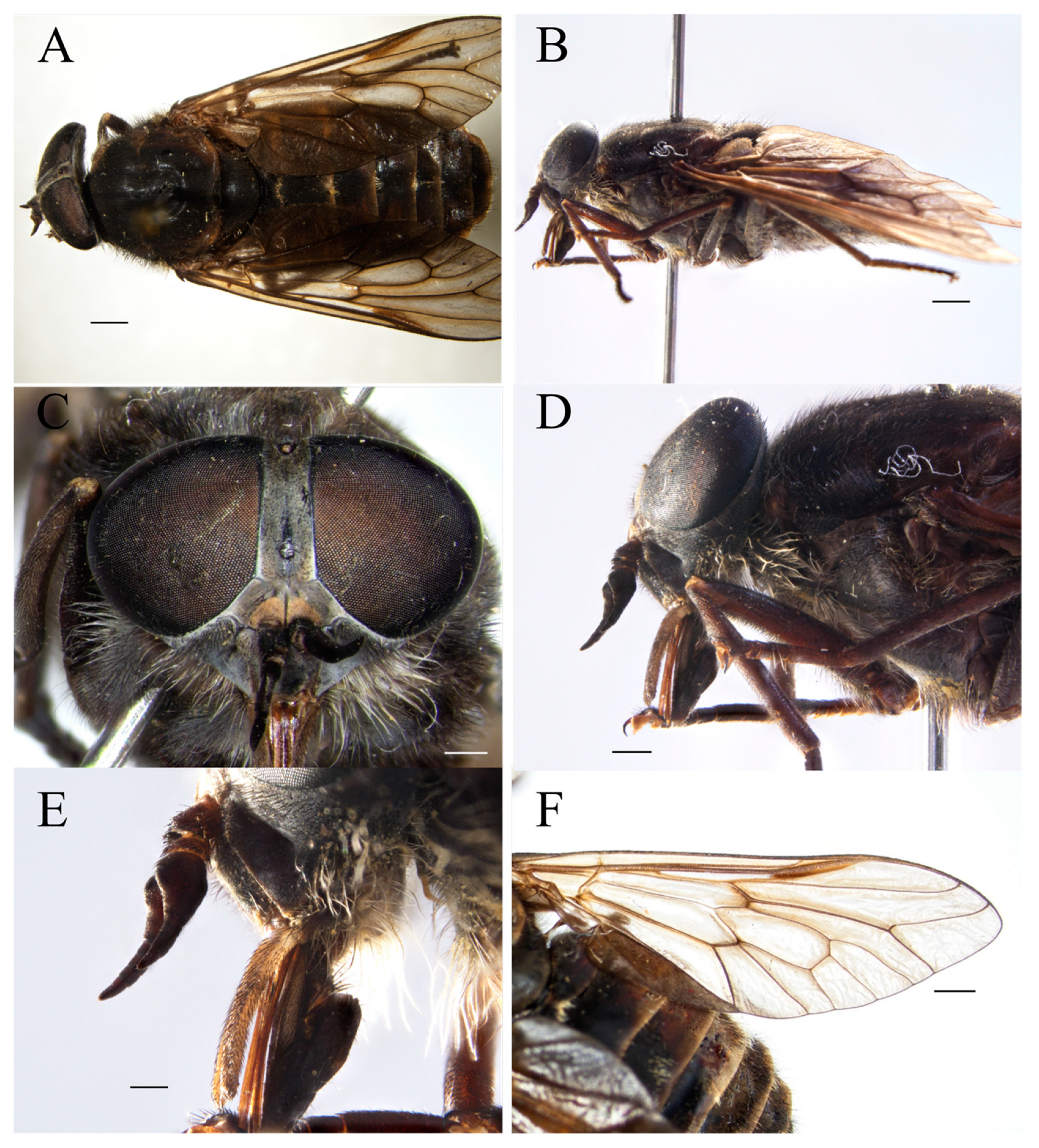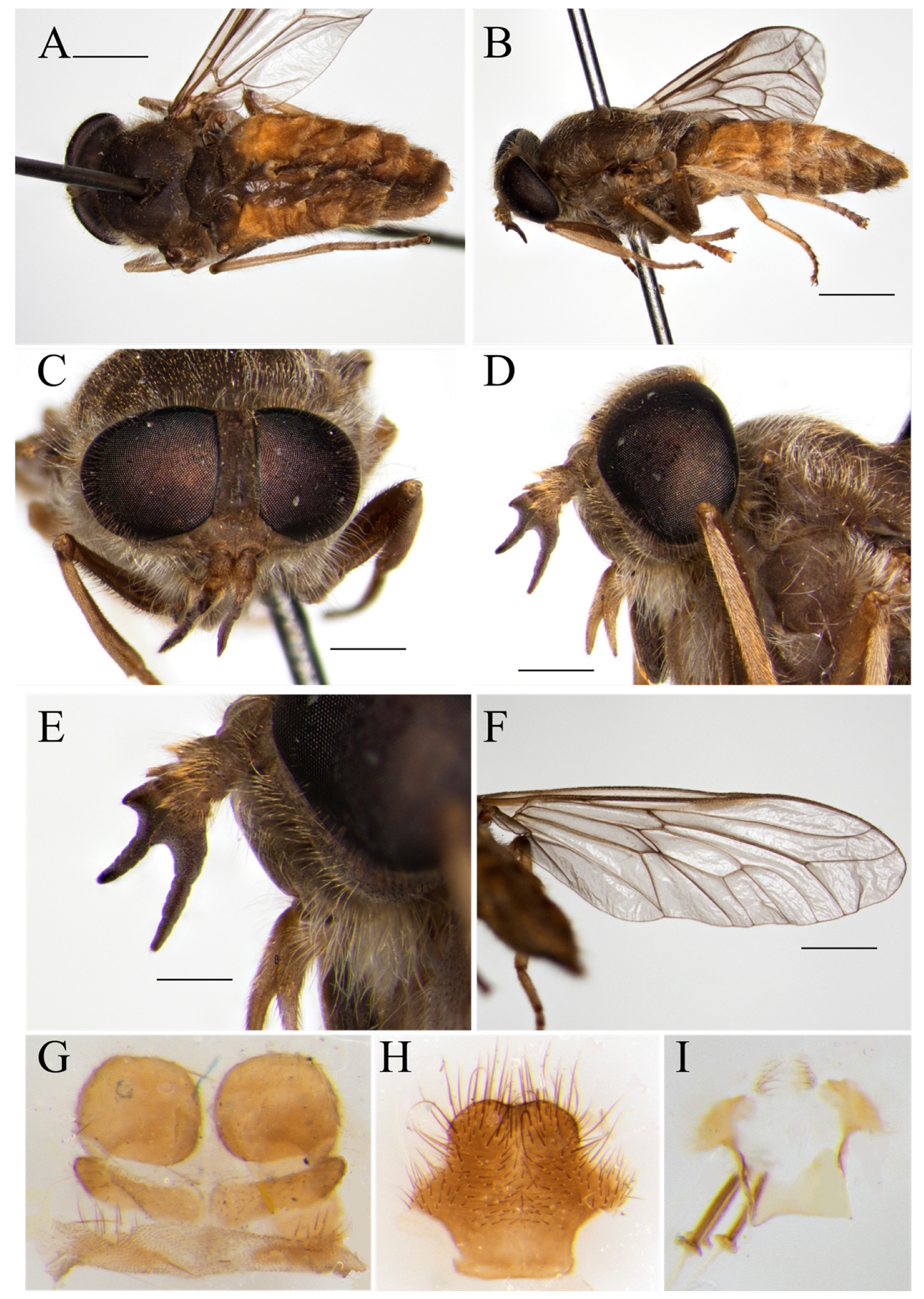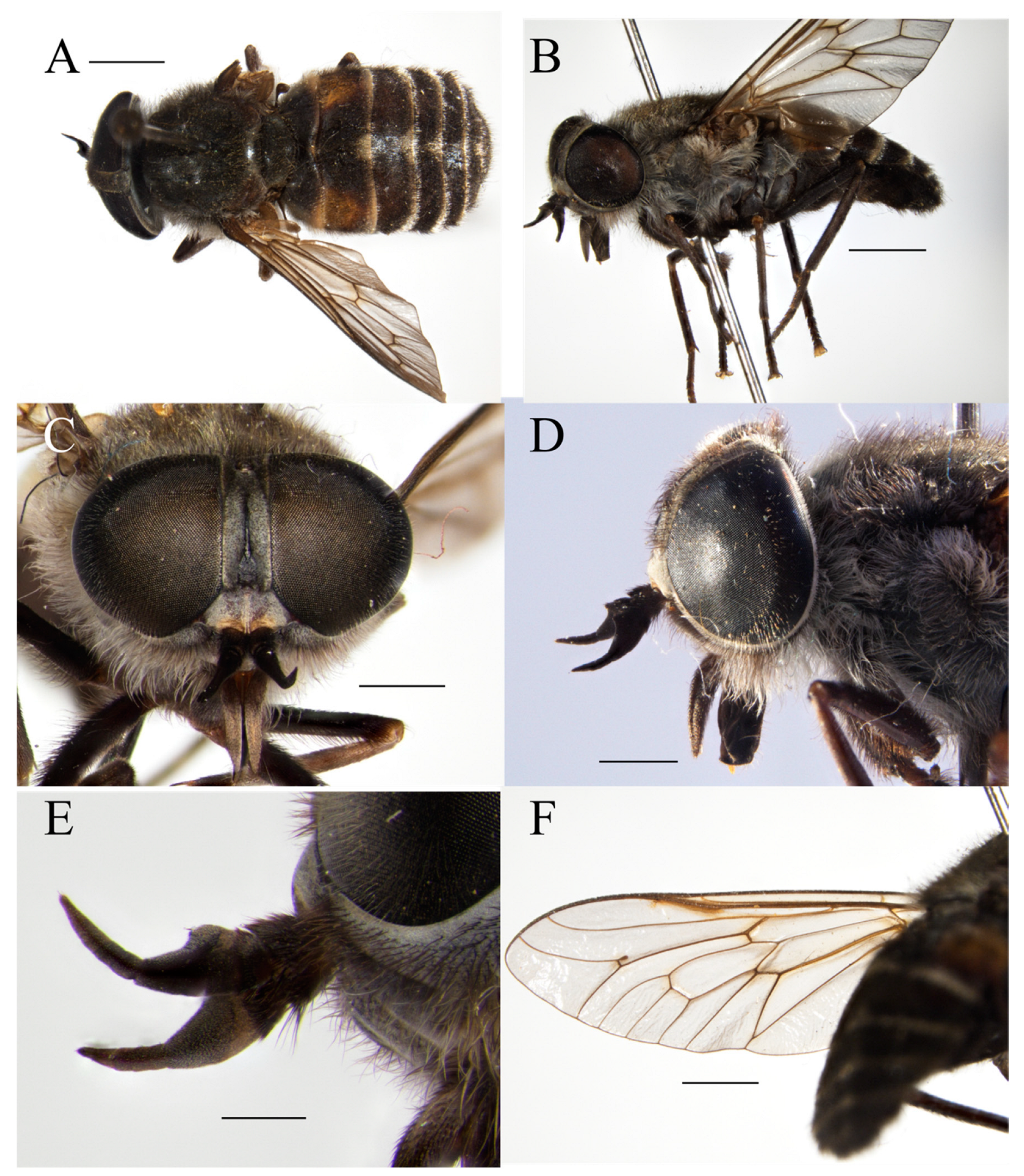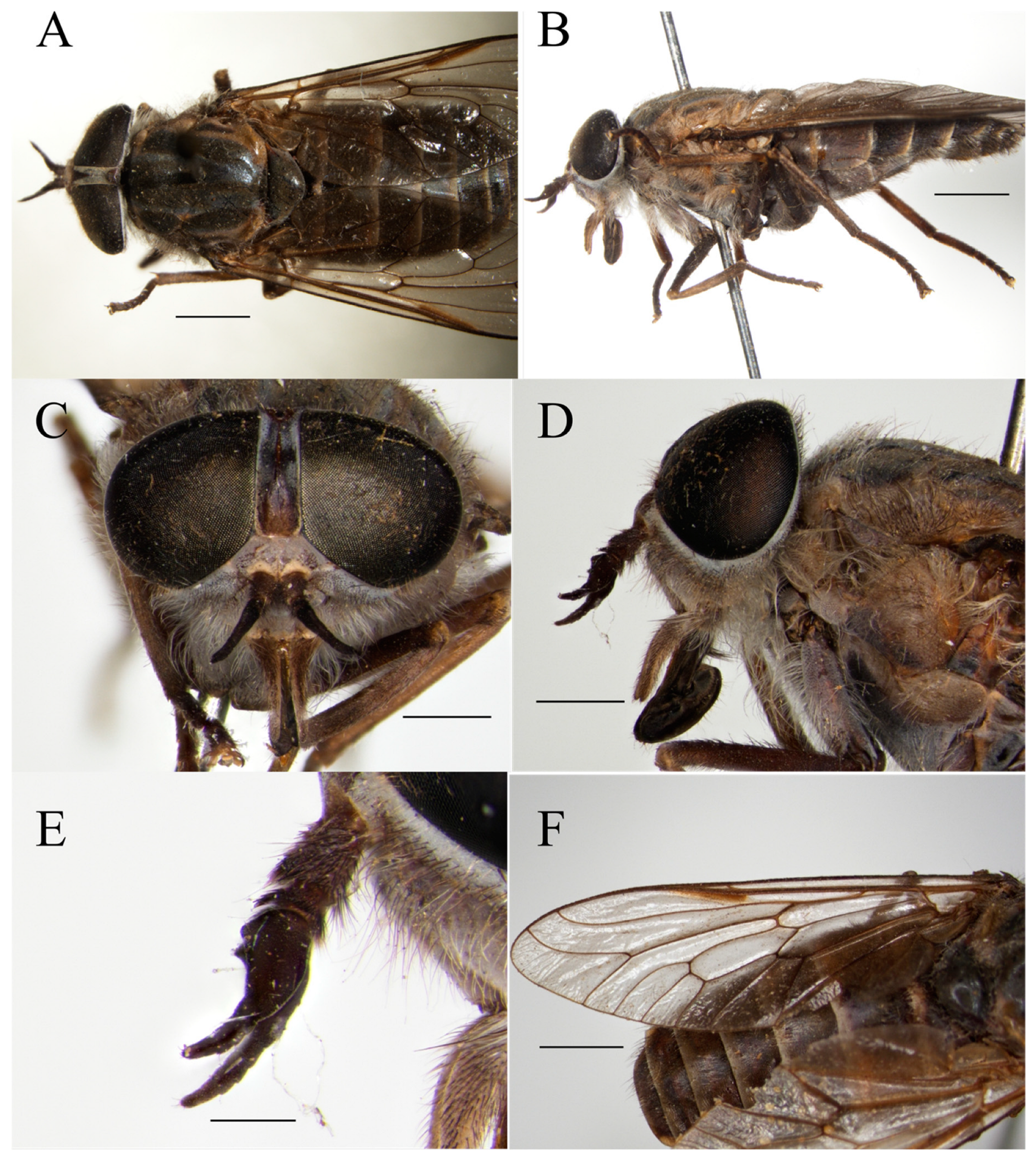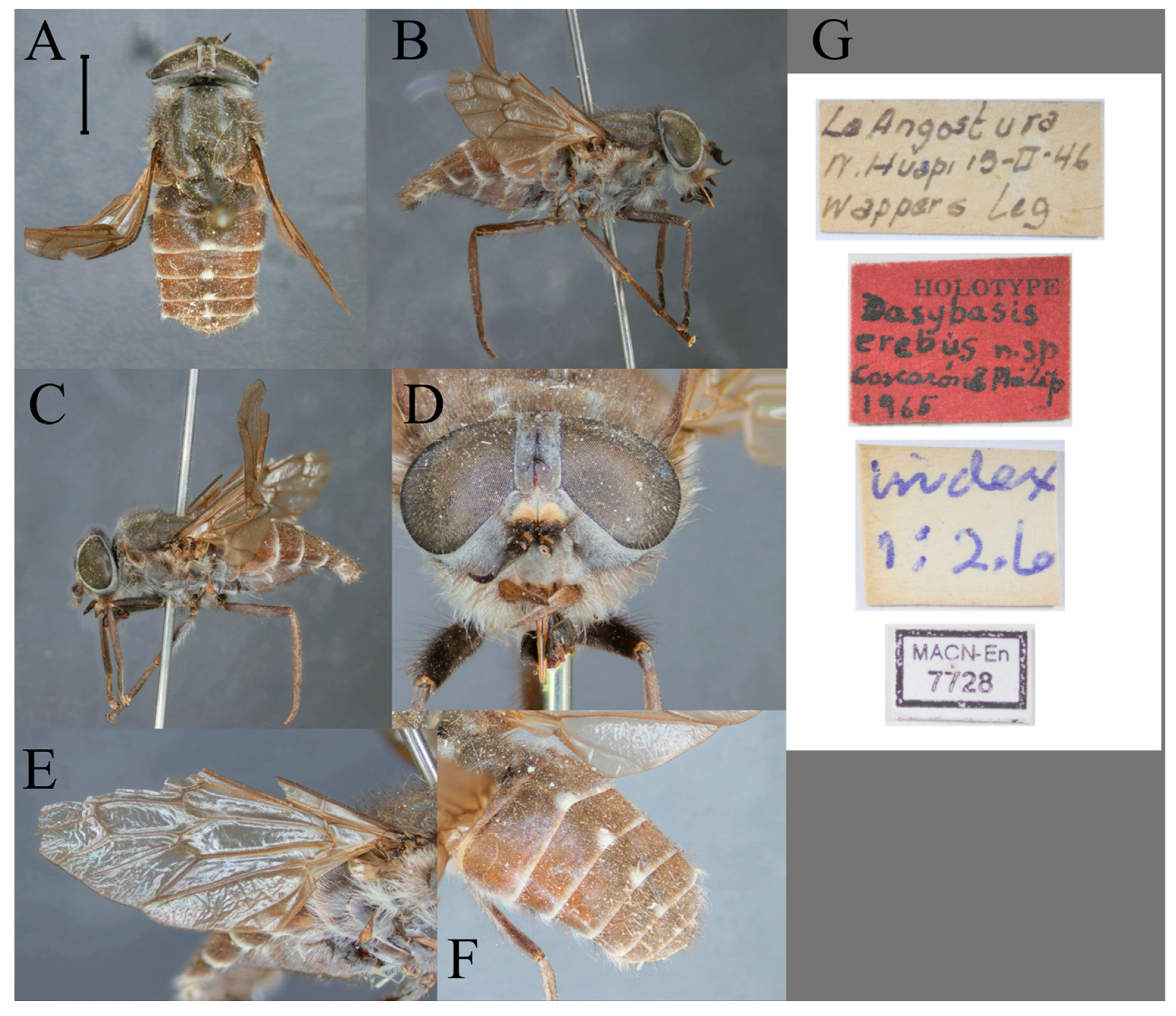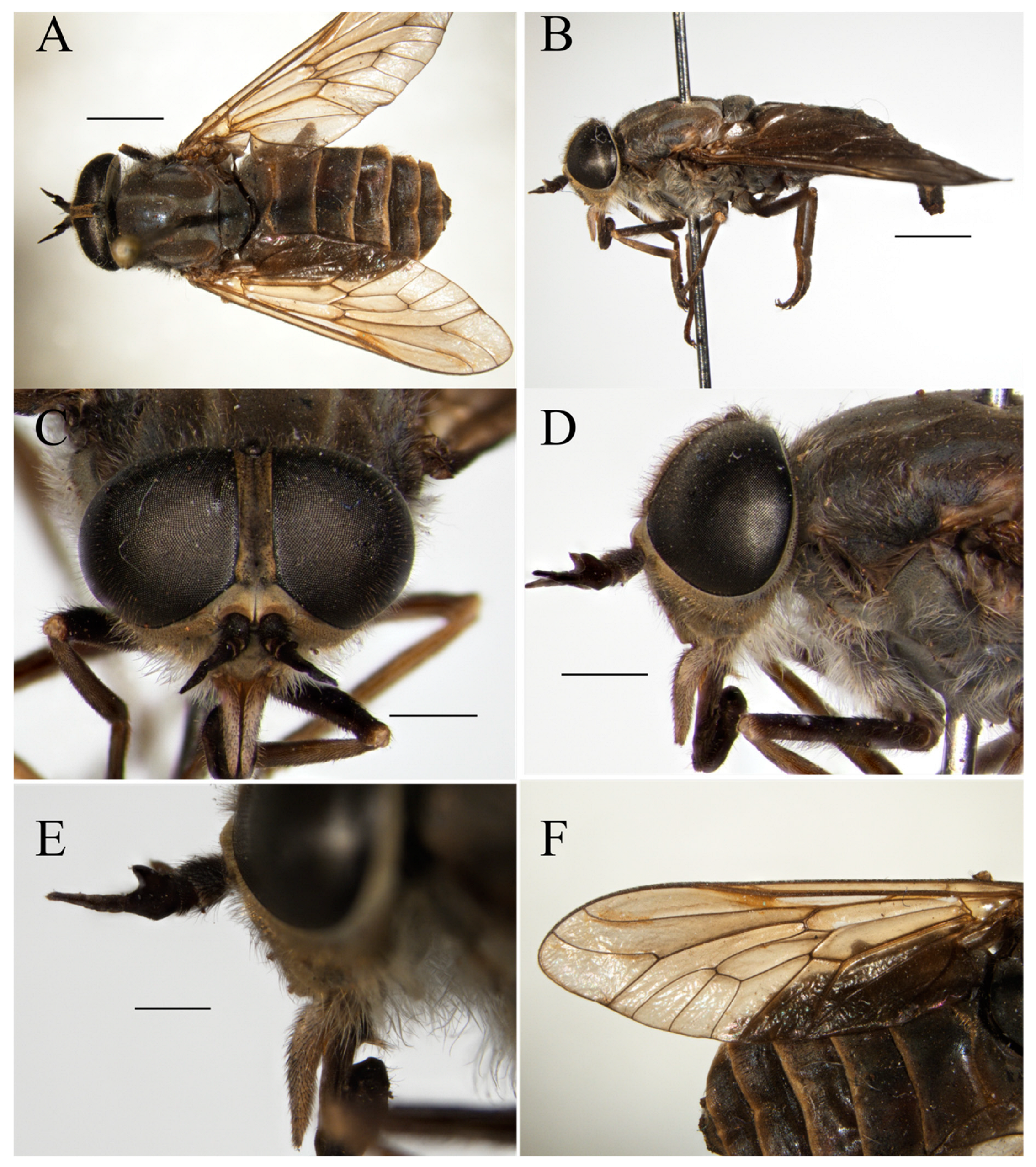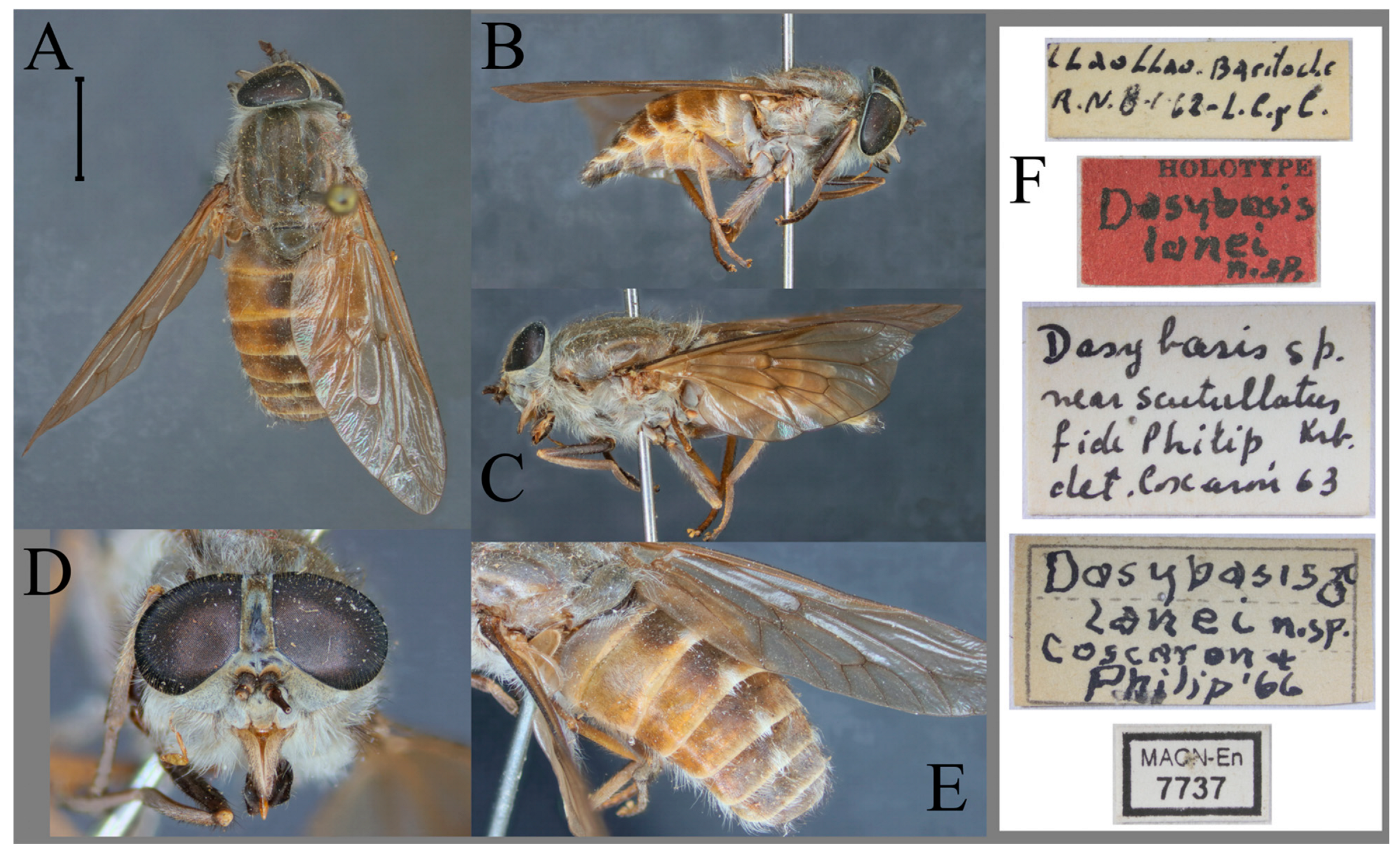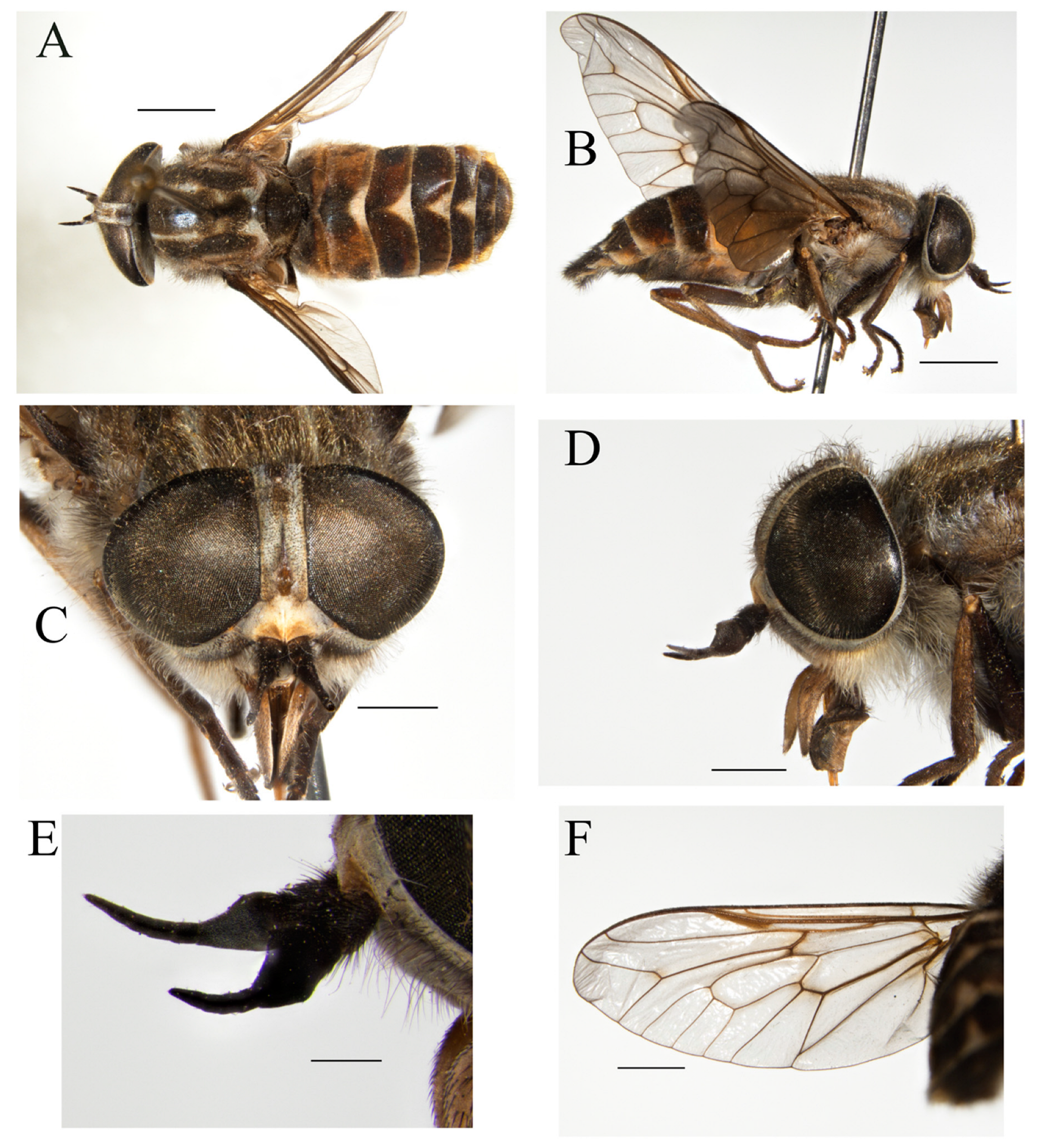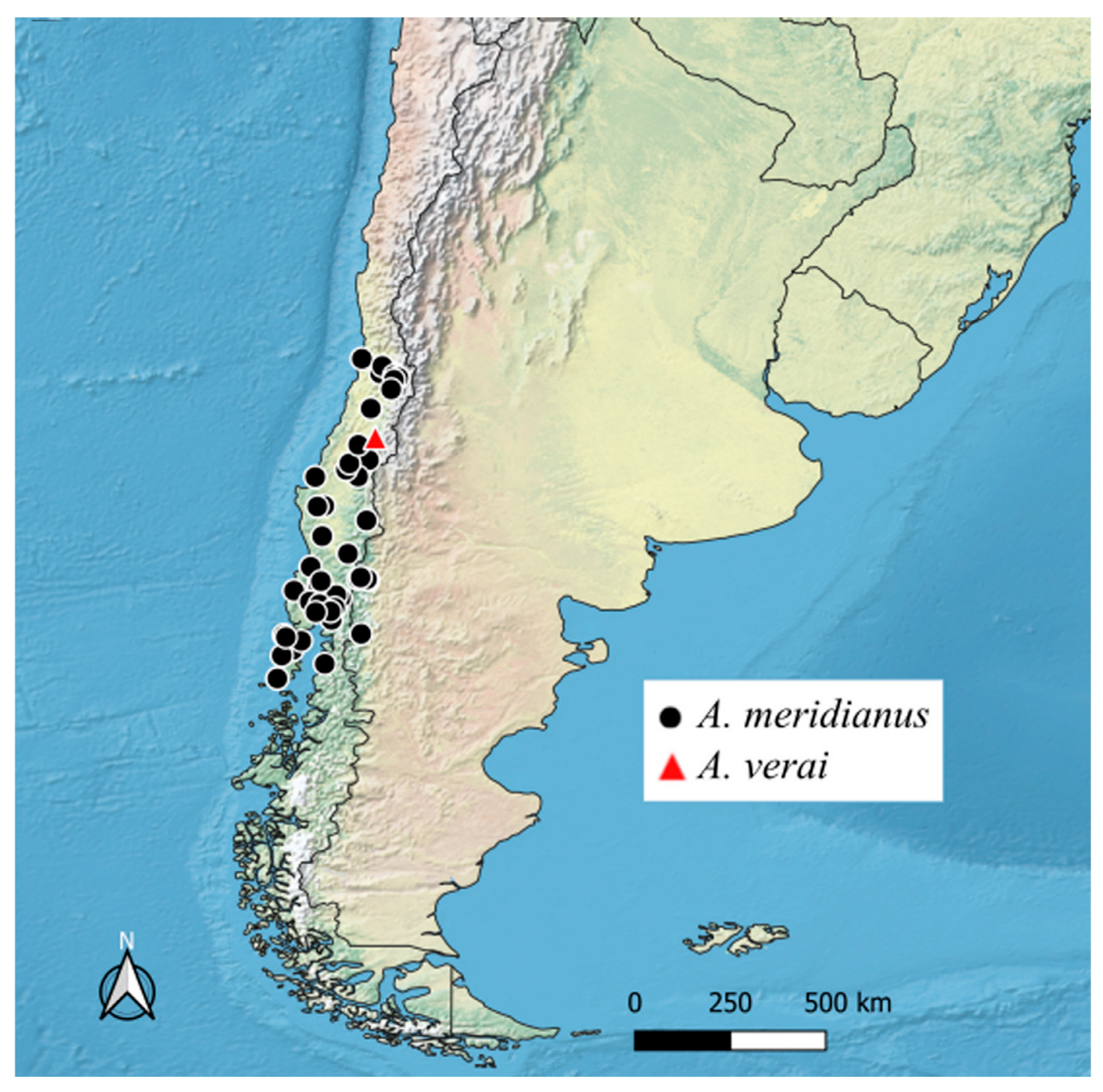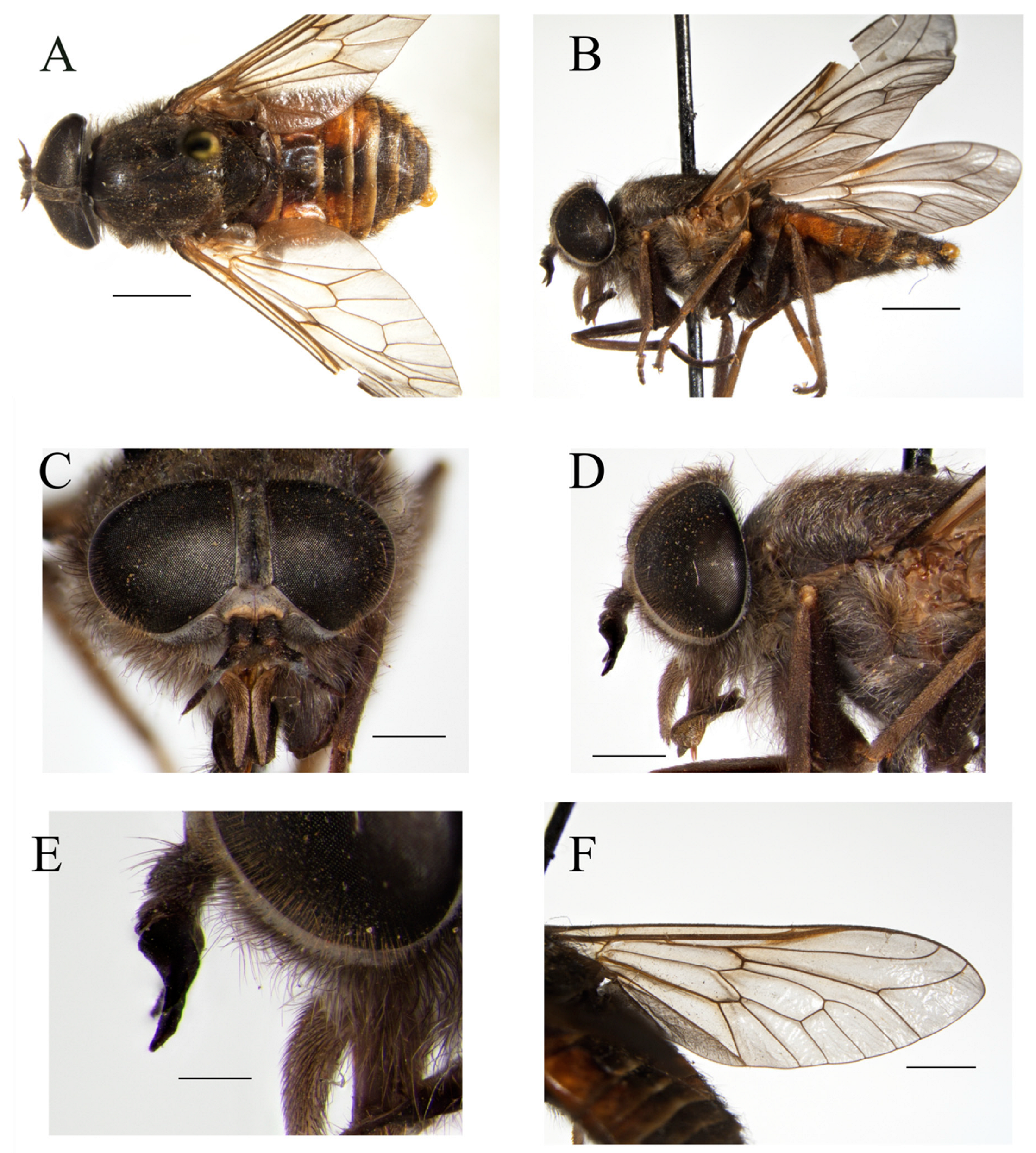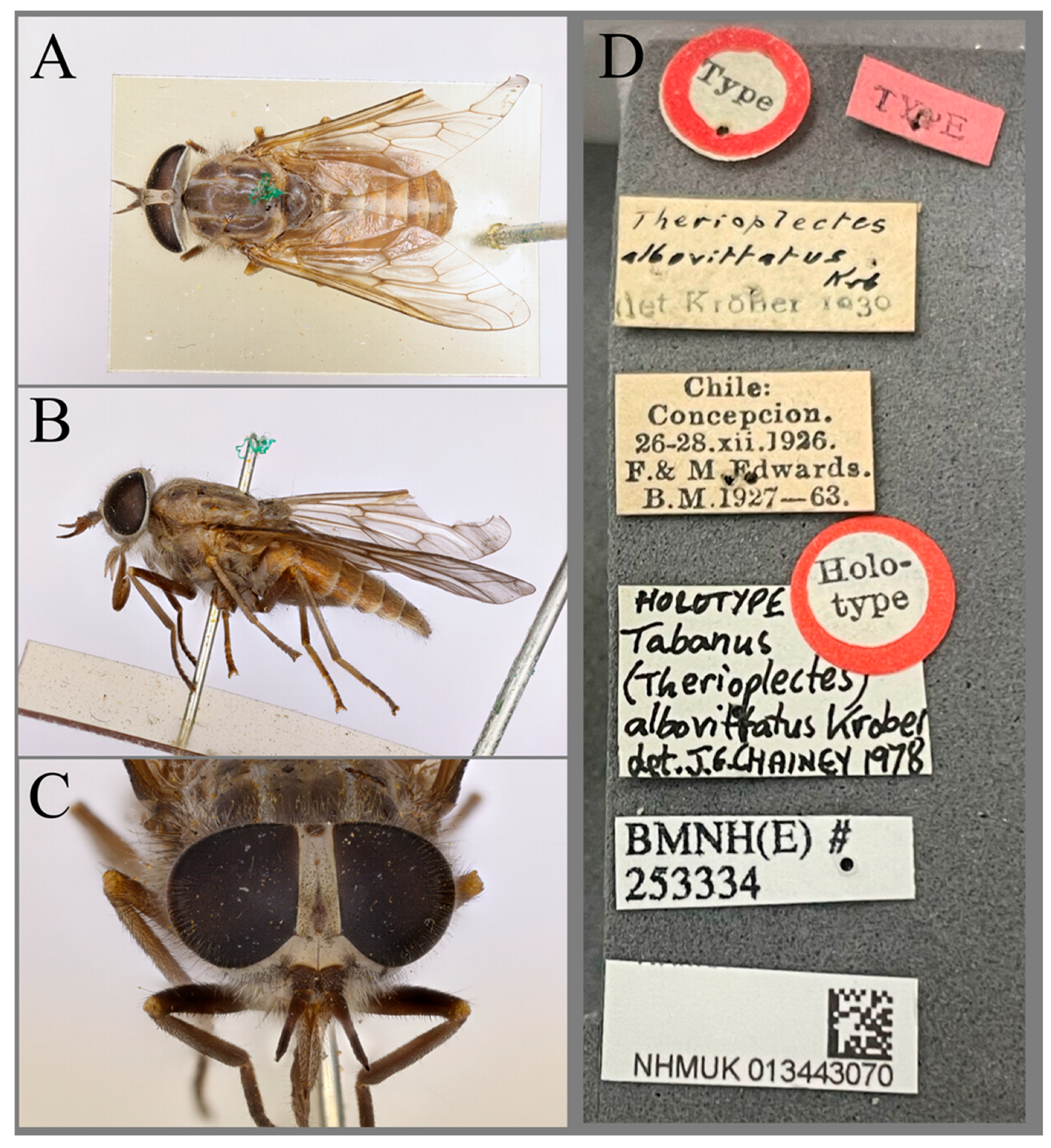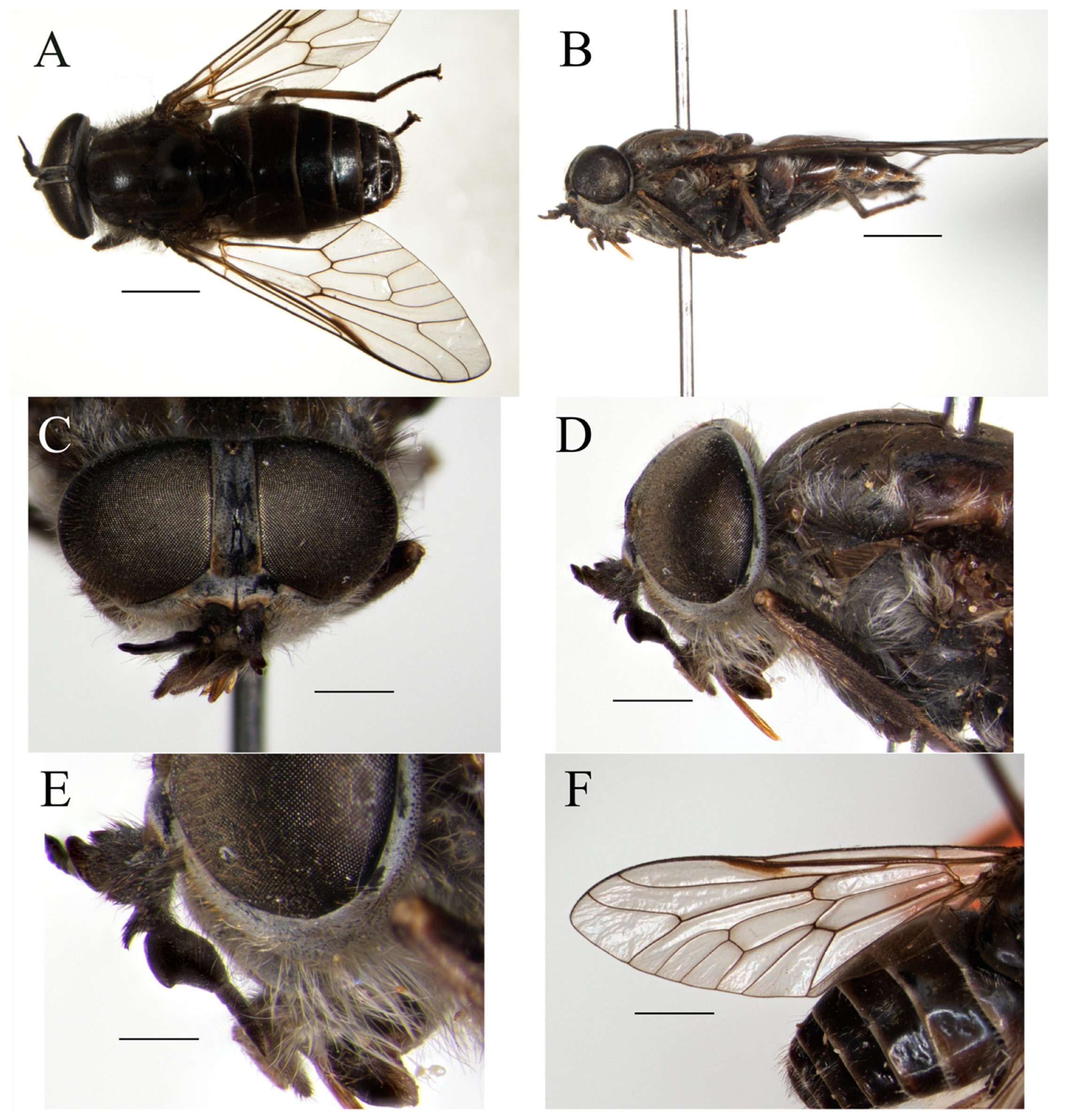1. Introduction
The Andean region comprises three subregions—Central Chilean, Subantarctic, and Patagonian—and extends between 30 and Cabo de Hornos, the archipelago of southern Chile and Argentina. Tabanid species of the Andean genus
Agelanius Rondani, 1863 are restricted to central and southern Chile and southwestern Argentina (Coscarón & Philip, 1967b [
1]; González, 1999 [
2]), primarily in the foothills of the Andes. Rondani [
3] described the genus as including the species
A. meridianus, the type species, and
A. philippii, characterizing the included species only as having “pilose eyes”, without designating a type species, which was subsequently designated by Coquillett [
4].
Kertész [
5] treated the two species described by Rondani [
3] within
Tabanus Linnaeus. Coquillett [
4] pointed out that
Agelanius is similar to
Tabanus. Enderlein [
6] recognized it as a genus, differentiating it from
Archiplatius in his key (Enderlein [
6]). Enderlein (1925 [
7]) included
Agelanius in a subsequent key, extending the diagnosis made by Rondani [
3], listing ten species in the genus, including four newly described ones.
Kröber [
8] still considered
Agelanius as having generic rank, although later [
9,
10], he treated it again as a subgenus of
Tabanus, as did Borgmeier [
11]. Kröber [
10], in his catalog of the Tabanidae of Central and South America, continued to consider
Agelanius as a subgenus of
Tabanus and synonymized
Archiplatius with
Agelanius. Stone [
12] treated
Agelanius as a genus and, together with
Archiplatius Enderlein, considered it a synonym of
Dasybasis Macquart, 1847 for the first time. Bequaert & Renjifo [
13] also treated
Agelanius as having generic rank and, additionally, described a new species,
A. osornoi. Mackerras [
14] considered
Agelanius to be a genus of Diachlorini.
Coscarón & Philip [
1], in their revision of the genus
Dasybasis in the Neotropical region, considered
Agelanius to be a subgenus of
Dasybasis, recognizing eight species, three subspecies, and one species of uncertain placement in the genus. González [
2] reestablished the generic rank of
Agelanius based on morphological characters (eyes with abundant ommatrichia, frons narrow, basal callus keel shaped, and maxillary palpus slender and elongate) different from those characters in
Dasybasis and recognized nine species. In addition, he transferred to the genus
Acellomyia González, 1999 three species (
A. fontanensis (Coscarón, 1962),
A. lauta (Hine, 1920), and
A. paulseni (Philippi, 1865)) and one subspecies (
A. paulseni mapuche (Coscarón & Philip, 1967)). Finally, González [
15] revalidated the subgenus
Styphocera Philip, 1969 by transferring
A. antennina (Philip) to the genus
Stypommisa Philip, 1969. To summarize, the genus
Agelanius currently comprises 12 valid species:
A. aquila (Coscarón & Philip, 1967),
A. burgeri González, 2006,
A. chiloensis González, 2009,
A. cortesi (González, 1996),
A. dominus González, 1999,
A. erebus (Coscarón & Philip, 1967),
A. fuscus González, 2004,
A. lanei (Coscarón & Philip, 1967),
A. meridianus Rondani, 1863,
A. philippii Rondani, 1863,
A. scutulata (Kröber, 1930), and
A. verai González, 2004.
The aims of this study were to describe a thirteenth species of Agelanius, to provide a diagnosis for each species in the genus, and to present a new key to Agelanius.
3. Results
3.1. Taxonomy
Tabanidae Latreille, 1802
Tabaninae Latreille, 1802
Diachlorini Lutz, 1909
3.2. Genus Agelanius Rondani
Agelanius Rondani, 1863: 79 (as genus) [
3]. Type-species:
Agelanius meridianus Rondani (sub. des.) Coquillett, 1910: 504 (list) [
4]; Kröber 1930: 149 (as a subgenus of
Tabanus) [
9]; Kröber, 1934: 298 (cat. as a subgenus of
Tabanus) [
10]; Bequaert & Renjifo 1946: 86 (tax., new species) [
13]; Coscarón & Philip, 1967a: 96 (keys) [
18]; Coscarón & Philip 1967b: 194 (rev.) [
1]; Fairchild, 1969: 216 (com. as a subgenus of
Dasybasis) [
19]; Fairchild 1971: 43 (cat.) [
20]; Moucha 1976: 223 (cat.) [
21]; Fairchild & Burger 1994: 70 (cat.) [
22]; Coscarón & Papavero, 1993: 9 (in key as a subgenus of
Dasybasis), 117 (plate 81,
A. lanei) [
23]; Coscarón & Papavero, 2009a: 3 (list), 16 (in key), 115 (figure 87,
A. lanei) [
24]; Coscarón & Papavero, 2009b: 58 (cat., as genus) [
25]; O’Hara et al., 2011: 27 (tax.) [
26]; Coscarón & Papavero, 2014: 2 (list), 4, 6 (in key) [
27]; Morita et al., 2016: 64–66 (phy.) [
28]; Guimaraes et al., 2017: 74 (diag.) [
29]; González et al., 2022: 229 (cat.) [
30].
Styphocera Philip, 1969: 151 (as a subgenus of
Stypommisa) [
31]. Type-species:
Stypommisa (
Styphocera)
antennina Philip (mon.). González, 2023: 164 (tax., transferred to genus
Stypommisa Enderlein) [
15].
3.2.1. Diagnosis
Species of Agelanius, including the type species, except A. dominus, have a conspicuous brown body. Features: Small-to-medium-sized species (8.5–15.5 mm); frons narrow; frontal index 2.2–4.0, lateral margins slightly divergent except parallel in A. cortesi, A. erebus, A. lanei, and A. meridianus; basal callus keel shaped and not touching the eyes or subcallus; eyes with abundant ommatrichia, sparse in A. burgeri, without bands; ocellar triangle with three ocelli developed, vestigial in A. chiloensis; pedicel with short dorsal projection; postpedicel with dorsal prolongation in A. augustus sp. nov., A. chiloensis, A. fuscus, A. lanei, and A. philippii and with a dorsal angle in A. aquila, A. burgeri, A. cortesi, A. erebus, A. meridianus, A. scutulata, and A. verai; maxillary palpus slender and elongate, with short and abundant setulae; subcallus without setulae except in A. burgeri, A. chiloensis, A. dominus, A. lanei, A. philippii, and A. verai. Scutum with narrow, pale stripes except in A. aquila, A. augustus sp. nov., and A. burgeri; mesopleuron (anepisternum, anepimeron, and katepisternum) with abundant, long, grayish or yellowish setulae; postspiracular scale with whitish setulae; legs dark brown or brown; wings infuscated brown except A. chiloensis and A. dominus, wings of which are hyaline; basicosta usually bare except A. aquila and A. meridianus, which have sparsely setose basicostae; Sc and R1 setose; R4 without appendix except A. meridianus. Abdomen brown, generally with pale median triangles on some tergites; cerci subcircular; hypogynial valve with border concave and weakly projected; hypogynium with wide, straight base; genital fork with straight base; spermathecal ducts long; spermatheca distally acuminate, with wide base.
3.2.2. Distribution
Agelanius species occur from central Chile and southern Argentina and Chile.
3.3. Agelanius aquila (Coscarón & Philip, 1967)
Dasybasis (
Agelanius)
aquila Coscarón & Philip, l967a: 98 [
18]. Coscarón & Philip, 1967b: 238 (desc.) [
1].
Dasybasis (
Agelanius)
aquila Coscarón & Philip, l967a [
18]. Fairchild, 1971: 43 (cat.) [
20]; Moucha, 1976: 223 (cat.) [
21]; Fairchild & Burger, 1994: 70 (cat.) [
22]; Bachmann, 2012: 99 (typ.,
Dasybasis (
Agelanius)) [
32].
Agelanius aquila Coscarón & Philip, l967a [
18]. González, 1999: 142 (in key), 144 (redes.) [
2]; Coscarón & Papavero, 2009b: 58 (cat.) [
25]; González et al., 2022: 229 (cat.) [
30].
Holotype. ♀ (FSCA). Type-locality. Chile, Aysén, Rio Aysén.
Diagnostic redescription. Female. Length 14.0–15.0 mm; wing 13.5 mm. Body color dark brown (
Figure 1A,B). Frons pruinose dark gray brownish with short black setulae, lateral margins slightly divergent; frontal index 2.8–3.3. Basal callus black, not touching eyes, with keel-shaped projection extending more than half the height of the frons, not touching subcallus (
Figure 1C). Eyes with abundant short brown ommatrichia (
Figure 1D). Ocellar triangle with three developed ocelli. Subcallus blackish, pruinose, without setulae. Parafacials and genae pruinose blackish brown with short black setulae. Clypeus pruinose blackish with long grayish setulae. Antennae black; postpedicel wide, longer than pedicel, with dorsal median angle rounded (
Figure 1E). Maxillary palpus pruinose grayish, with abundant short black setulae (
Figure 1E). Scutum dark brown without stripes but with abundant brown setulae. Postpronotal lobes dark brownish with long black and brown setulae. Scutellum blackish brown with short setulae on disc and long brown setulae laterally. Pleura pruinose dark gray with abundant gray-black setulae. Legs dark brown; coxae and femora with long brown setulae; tibiae and tarsi with short brown setulae. Wings infuscated, without appendix on R
4 (
Figure 1F). Upper calypteres yellowish, lower calypteres concolorous, with minute setulae. Abdomen dark brown dorsally, with distinct narrow pale hind margins, with abundant black and grayish setulae, middle of tergites with yellowish setulae. Sternites darker with abundant black setulae.
Male. Unknown.
Material examined. Argentina. Prov. Neuquen, 1♀, Catan Lil, 850 msnm, 14.I.1980, M. Gentile col.; Prov. Santa Cruz, 1♀, Lago Posadas, no date or col. Chile. Región de Aysén, Aysén Province, 1♀, Calbuco no date Schwabe col.; 1♀, Río Aysén, no other data; 2 ♀ PN Queulat, 19.I. 1999 C.R. González col.; 2 ♀ Laguna Las Torres C.R. González col.; 2 ♀, Puerto Puyuhuapi, 25.XII.1939, G.H. Schwabe col.; 1♀, no date, P. Dusen col.
Distribution. This species is known from Argentina (Neuquen to Santa Cruz Provinces) and Chile (Los Lagos to Aysén regions) (
Figure 2).
Figure 1.
Agelanius aquila (Coscarón & Philip, 1967). ♀ (A–F). (A) Habitus dorsal view (scale bar = 1 mm); (B) habitus lateral view (scale bar = 1 mm); (C) head frontal view (scale bar = 1 mm); (D) head lateral view (scale bar = 1 mm); (E) antenna (scale bar = 0.5 mm); (F) wing dorsal view (scale bar = 1 mm).
Figure 1.
Agelanius aquila (Coscarón & Philip, 1967). ♀ (A–F). (A) Habitus dorsal view (scale bar = 1 mm); (B) habitus lateral view (scale bar = 1 mm); (C) head frontal view (scale bar = 1 mm); (D) head lateral view (scale bar = 1 mm); (E) antenna (scale bar = 0.5 mm); (F) wing dorsal view (scale bar = 1 mm).
Figure 2.
Map showing distributional records of Agelanius Rondani: A. aquila (Coscarón & Philip, 1967); A. augustus sp. nov.; A. burgeri González, 2006; A. cortesi (González, 1996).
Figure 2.
Map showing distributional records of Agelanius Rondani: A. aquila (Coscarón & Philip, 1967); A. augustus sp. nov.; A. burgeri González, 2006; A. cortesi (González, 1996).
3.4. Agelanius augustus sp. nov.
Holotype. ♀ (UMCE). Type-locality. Chile, Chiloé Province, Punta Tique.
Diagnosis. Female. Length 11.5 mm; wing 10.5 mm. Body color pale brown. Frons brown, frontal index 2.8. Basal callus dark brown, with keel-shaped median projection. Eyes with abundant long brownish ommatrichia. Ocellar triangle with three well-developed ocelli. Postpedicel grayish with well-developed dorsal projection reaching the middle of the flagellomere, apical flagellomeres concolorous. Scutum dark brown, without longitudinal stripes, and with sparse yellowish setulae. Wings infuscated; vein R4 without appendix. Abdomen pale brown dorsally, with long yellowish setulae, posterior border of tergites lighter in color, lateral border of tergites with long grayish setulae. Sternites darker.
Female. Length 11.5 mm; wing 10.5 mm. Body color pale brown (
Figure 3A,B).
Head. Frons brown, pruinose yellowish, bearing short, sparse yellowish setulae; frons narrow, lateral margins slightly divergent, frontal index 2.8. Basal callus dark brown, with keel-shaped median projection extending more than half the height of the frons, not touching eyes or subcallus (
Figure 3C). Eyes brownish with abundant long brownish ommatrichia (
Figure 3D). Ocellar triangle with three well developed ocelli. Subcallus yellowish brown, with sparse black setulae laterally. Parafacials and genae pruinose grayish yellow with long yellowish setulae. Clypeus pruinose grayish with sparse grayish setulae. Antennal scape yellow grayish with long yellowish setulae dorsally and laterally; pedicel concolorous, with short, yellowish setulae, with dorsal projection. Postpedicel grayish, with well-developed dorsal projection reaching the middle of the flagellomere, apical flagellomeres concolorous (
Figure 3E). Maxillary palpus pruinose, grayish, with abundant short yellowish setulae; first segment grayish, with long gray setulae; second segment 3.5X length of first, with yellowish setulae (
Figure 3E). Proboscis dark brown; labella brown, large, fleshy. Occiput pruinose dark gray with short semi-erect black setulae.
Thorax. Scutum dark brown, without longitudinal stripes, and with sparse yellowish setulae. Postpronotal lobes lighter in color, with long gray setulae. Scutellum dark brown with long yellowish setulae only on dorsal surface and posterior border. Pleura pruinose dark brown with long grayish setulae; anepisternum, katepisternum, and katatergite with long yellowish setulae; anatergite dark with whitish infrasquamal setulae. Legs pale brown, coxae and femora concolorous, with long yellowish-gray setulae, tibiae with yellowish setulae, tarsi with short black and yellowish setulae. Wings infuscated; Sc and R
1 setose; vein R
4 without appendix (
Figure 3F). Basicosta bare. Halter dark brown. Squamae concolorous with wing base. Upper calypteres yellowish gray, lower calypteres lighter in color.
Abdomen. Pale brown dorsally, with long yellowish setulae, posterior border of tergites lighter in color, lateral border of tergites with long grayish setulae, medially tergites with whitish spots. Sternites darker, with abundant yellowish setulae and a few black setulae. Terminalia. Cerci subcircular with long setulae (
Figure 3G); hypogynial valve with border concave, weakly projected and long setulae; hypogynium with wide, straight base (
Figure 3H); genital fork with straight base; spermathecal ducts long; spermatheca distally acuminate and with wide base (
Figure 3I).
Male. Unknown.
Material examined. Chile. Región de Los Lagos, Chiloé Province: 1♀ Isla Surgidero, 17.I.1987, J. Solervicens col.
Immature stages. Unknown.
Distribution. Known only from Chiloé island, Chile (
Figure 2).
Etymology. The species is named in honor of entomologist Dr. Augusto Loureiro Henriques, a researcher at the Instituto Nacional de Pesquisas da Amazonia, friend and specialist in the family Tabanidae.
3.5. Agelanius burgeri González, 2006
Agelanius burgeri González, 2006: 59 [
33]. Coscarón & Papavero, 2009b: 58 (cat.) [
25]; González et al., 2022: 230 (cat.) [
30].
Holotype. ♀ (UMCE). Type-locality. Chile, Cautín Province, Nueva Imperial.
Diagnostic redescription. Female. Length 8.5 mm; wing 9.5 mm. Body color pale brown (
Figure 4A,B). Frons pruinose pale brown, grayish with short black setulae, narrow, lateral margins slightly divergent, frontal index 3.0. Basal callus brown with keel-shaped median projection extending more than half the height of the frons, not touching subcallus (
Figure 4C). Eyes with sparce short brownish ommatrichia (
Figure 4D). Ocellar triangle with three vestigial ocelli. Subcallus grayish with sparse black setulae laterally. Parafacials and genae pruinose whitish gray, with long whitish setulae and sparse black setulae. Clypeus pruinose grayish with sparse black setulae. Antennae brown; postpedicel with low dorsal median angle (
Figure 4E). Maxillary palpus pruinose yellowish gray with abundant short black setulae (
Figure 4E). Scutum dark brown, without stripes. Postpronotal lobes brownish gray with long gray setulae. Scutellum dark brown, with long grayish setulae only on dorsal and lateral borders. Pleura pruinose pale brown with long yellowish gray setulae Legs light brown; coxae and femora concolorous, with long yellowish-gray and black setulae; tibiae and tarsi with short black setulae. Wings slightly infuscated, without appendix on R
4 (
Figure 4F). Upper calypteres whitish, lower calypteres yellowish. Abdomen pale brown dorsally, with short yellowish gray and black setulae, posterior border of tergites lighter in color, lateral border of tergites with long grayish and some black setulae. Sternites darker, with abundant short black setulae.
Male. Length 9.0 mm; wing 9.5 mm. Similar to female except eyes with longer and denser ommatrichia and genae without black setulae. Subcallus bare. Scape and pedicel lighter in color, with longer setulae. Maxillary palpus grayish, short, stout, with abundant long black setulae. Pleura dark gray, with abundant long yellowish-white setulae.
Material examined. Chile. Región de La Araucanía, Cautín Province: 1♀, Nueva Imperial 6.I.1942, D.S. Bullock col.; 1♂ with same data.
Distribution. Known only from the type-locality in southern Chile (
Figure 2).
Figure 3.
Agelanius augustus sp. nov. ♀ (A–I). (A) Habitus dorsal view (scale bar = 1 mm); (B) habitus lateral view (scale bar = 1 mm); (C) head frontal view (scale bar = 1 mm); (D) head lateral view (scale bar = 1 mm); (E) antenna (scale bar = 0.5 mm); (F) wing dorsal view (scale bar = 1 mm); (G) tergites IX and X, cerci and hypoproct, dorsal view; (H) hypogynium+ hypogynial valve, dorsal view; (I) genital fork, dorsal view.
Figure 3.
Agelanius augustus sp. nov. ♀ (A–I). (A) Habitus dorsal view (scale bar = 1 mm); (B) habitus lateral view (scale bar = 1 mm); (C) head frontal view (scale bar = 1 mm); (D) head lateral view (scale bar = 1 mm); (E) antenna (scale bar = 0.5 mm); (F) wing dorsal view (scale bar = 1 mm); (G) tergites IX and X, cerci and hypoproct, dorsal view; (H) hypogynium+ hypogynial valve, dorsal view; (I) genital fork, dorsal view.
Figure 4.
Agelanius burgeri González, 2006. Holotype ♀ (A–F). (A) Habitus dorsal view (scale bar = 1 mm); (B) habitus lateral view (scale bar = 1 mm); (C) head frontal view (scale bar = 1 mm); (D) head lateral view (scale bar = 1 mm); (E) antenna (scale bar = 0.5 mm); (F) wing dorsal view (scale bar = 1 mm).
Figure 4.
Agelanius burgeri González, 2006. Holotype ♀ (A–F). (A) Habitus dorsal view (scale bar = 1 mm); (B) habitus lateral view (scale bar = 1 mm); (C) head frontal view (scale bar = 1 mm); (D) head lateral view (scale bar = 1 mm); (E) antenna (scale bar = 0.5 mm); (F) wing dorsal view (scale bar = 1 mm).
3.6. Agelanius chiloensis González, 2009
Agelanius chiloensis González, 2009: 11–15 [
34]. González et al., 2022: 230 (cat.) [
30].
Holotype. ♀ (UMCE). Type-locality. Chile, Chiloé Province, Isla Surgidero, Archipiélago Guapiquilan.
Diagnostic redescription. Female. Length 11.5 mm; wing 11.0 mm. Body color brown (
Figure 5A,B). Frons pruinose pale brown, darker on ocellar triangle, bearing long, abundant black setulae, narrow, lateral margins slightly divergent, frontal index 2.3. Basal callus pale brown, with keel-shaped median projection short, with groove in the middle, not extending more than half the height of the frons. Eyes with abundant long brownish ommatrichia (
Figure 5C). Ocellar triangle with vestigial ocelli. Subcallus pruinose yellowish, with black setulae laterally. Parafacials and genae pruinose yellowish with long blackish setulae. Clypeus yellowish, bearing short brownish setulae laterally. Antenna dark gray brown; postpedicel dark brown with developed dorsal projection (
Figure 5D,E). Maxillary palpus pruinose grayish with abundant short black setulae. Scutum dark brown with two longitudinal brownish stripes. Postpronotal lobes brownish gray with blackish setulae. Scutellum dark brown, without pruinosity, with long blackish setulae only on the lateral border. Pleura brownish gray with long yellowish setulae. Legs dark brown; coxae and femora grayish, with long gray setulae; tibiae and tarsi with abundant short black setulae. Wings hyaline; without appendix on R
4 (
Figure 5F). Upper calypteres whitish, lower calypteres yellowish with whitish setulae. Abdomen pale brown dorsally, with short brown setulae, middle of tergites lighter in color, with pale brown setulae and with pale brownish pilose median triangles; lateral border of tergites with long pale brown setulae. Sternites brownish gray with abundant short black setulae.
Male. Unknown
Material examined. Chile. Región de Los Lagos, Osorno Province: 3♀, Lago Puyehue 23.I.1992, C.R. González col.
Distribution. Known only from the type-locality in the southern Andes of Chile (
Figure 6).
3.7. Agelanius cortesi (González, 1996)
Dasybasis (
Agelanius)
cortesi González, 1996: 733 in González & Henry, 1999 [
35].
Agelanius cortesi González, 1996 [
35]. Coscarón & Papavero, 2009b: 58 (cat.) [
25]; González et al., 2022: 230 (cat.) [
30].
Holotype: ♀ (UMCE). Type-locality. Chile, Región Metropolitana, Cordillera Province, Río Clarillo, Quebrada Los Almendros.
Diagnostic redescription. Female. Length 12.0–13.5 mm; wing 11.5 mm. Body color dark brown (
Figure 7A,B). Frons pale gray brown, bearing short black setulae, parallel sided, ocellar triangle pruinose grayish; frontal index 4.0. Basal callus black with keel-shaped median projection (
Figure 7C). Eyes with abundant grayish ommatrichia (
Figure 7D). Ocellar triangle with three well-developed ocelli. Subcallus pruinose pale brown, without setulae, darker near antennae. Parafacials and genae pruinose gray with some black setulae adjacent to antenna and lateral borders. Clypeus pruinose grayish with long blackish setulae laterally. Antennae blackish gray; postpedicel black, with low dorsal median angle (
Figure 7E). Maxillary palpus pruinose blackish with short black setulae. Scutum brown with black and golden setulae and narrow pale grayish stripes. Postpronotal lobes gray with long black and gray setulae. Scutellum dark gray, without pruinosity, with black-gray setulae that are longer than those on the scutum. Pleura pruinose dark gray with long black-gray setulae. Legs dark brown, coxae and femora with short black-gray setulae, remaining leg segments with abundant short black setulae. Wings infuscated, with dark brown clouds on the crossveins; vein R
4 with short appendix (
Figure 7F). Upper calypteres yellowish, lower calypteres darker, with minute whitish setulae. Abdomen dark brown dorsally, pale brown laterally on tergites 1 and 2, posterior border of tergites with distinct, narrow, pale grayish hind margins and gray setulae, the gray setulae on posterior margins expanding into median triangles. Sternites dark gray, mostly with blackish setulae.
Male. Length 10.0 mm, wing 11.0 mm. Similar to female except for the following: eyes with ommatrichia more abundant; upper median eye facets larger, clearly differentiated from lower facets, larger facetted areas pale brown. Genae with dense long gray setulae and black setulae near the eyes. Maxillary palpus pale brown with long grayish setulae, shorter than the proboscis. Scutum with diffused stripes, invested mostly with long black setulae but some short setulae present, at least anteriorly. Coxae with long gray setulae, femora with dense long black-gray setulae. Wing without an appendix on R
4 or clouds on crossveins. Pleura pruinose gray, darker than on female. Abdomen pale brown laterally on tergites 1–5; sternite 2–4 pale brown.
Figure 5.
Agelanius chiloensis González, 2009. Holotype ♀ (A–F). (A) Habitus dorsal view (scale bar = 1 mm); (B) habitus lateral view (scale bar = 1 mm); (C) head frontal view (scale bar = 1 mm). (D) head lateral view (scale bar = 1 mm); (E) antenna (scale bar = 0.5 mm); (F) wing dorsal view (scale bar = 1 mm).
Figure 5.
Agelanius chiloensis González, 2009. Holotype ♀ (A–F). (A) Habitus dorsal view (scale bar = 1 mm); (B) habitus lateral view (scale bar = 1 mm); (C) head frontal view (scale bar = 1 mm). (D) head lateral view (scale bar = 1 mm); (E) antenna (scale bar = 0.5 mm); (F) wing dorsal view (scale bar = 1 mm).
Figure 6.
Map showing distributional records of Agelanius Rondani. A. chiloensis González, 2009; A. dominus González, 1999; A. erebus (Coscarón & Philip, 1967); A. fuscus González, 2004.
Figure 6.
Map showing distributional records of Agelanius Rondani. A. chiloensis González, 2009; A. dominus González, 1999; A. erebus (Coscarón & Philip, 1967); A. fuscus González, 2004.
Material examined. Chile. Región Metropolitana, Cordillera Province, Paratypes 9♀, 4♂, Qda. Los Almendros, PN Río Clarillo, 27.X.1992, C.R. González col.
Distribution. Known only from the type-locality in the central Andes of Chile (
Figure 2).
3.8. Agelanius dominus González, 1999
Agelanius dominus González, 1999: 146–148 [
2]. Coscarón & Papavero, 2009b: 58 (cat.) [
25]; González et al., 2022: 230 (cat.) [
30].
Holotype: ♀ (UMCE). Type-locality. Chile, Cordillera Province, La Obra.
Diagnostic redescription. Female. Length 14.0–15.5 mm; wing 13.5 mm. Body color grayish (
Figure 8A,B). Frons pruinose grayish, yellowish near subcallus, darker near ocellar triangle, with black setulae, narrow, lateral margins slightly divergent; frontal index 2.6. Basal callus dark brown, with keel-shaped median projection more than half the height of the frons, pear shaped at the base, not touching the subcallus (
Figure 8C). Eyes with abundant brownish ommatrichia (
Figure 8D). Ocellar triangle with three well-developed ocelli. Subcallus pruinose yellowish medially, lighter in color near antenna, yellowish gray laterally, with black setulae laterally. Parafacials and genae pruinose grayish with long gray and black setulae. Clypeus grayish with long black setulae. Antennae blackish; postpedicel with slight dorsal angle (
Figure 8E). Maxillary palpus yellowish, with abundant short black setulae. Scutum dark brown with two narrow pale grayish stripes reaching transverse suture. Postpronotal lobes grayish brown with long black setulae and some shorter gray setulae. Scutellum dark brown on disc, with short black setulae shorter than on scutum, lateral border pruinose gray. Pleura pruinose gray yellowish with long gray setulae. Legs dark brown, coxae pruinose grayish with long gray setulae, especially on hind coxae, femora with long black and gray setulae, tibiae and remaining leg segments with abundant short black setulae. Wing hyaline, without appendix on R
4 (
Figure 8F). Upper calypteres yellowish, lower calypteres lighter in color, with whitish setulae. Abdomen dark brown dorsally, with abundant black setulae, pale brown laterally on tergites 1 and 2, with short grayish setulae, posterior border of tergites with bright yellowish pruinosity and with median grayish pilose triangles; tergites 5 and 6 with long black setulae laterally. Sternites brown, lighter in color than tergites, with abundant black setulae.
Male. Length 13.0–14.4 mm, wing 12.5 mm. Similar to female except as follows: eyes with ommatrichia more abundant; ocelli vestigial; scape pruinose gray; and maxillary palpus yellowish, short and stout, with abundant long black and gray setulae.
Figure 7.
Agelanius cortesi (González, 1996). Holotype ♀ (A–F). (A) Habitus dorsal view (scale bar = 1 mm); (B) habitus lateral view (scale bar = 1 mm); (C) head frontal view (scale bar = 1 mm); (D) head lateral view (scale bar = 1 mm); (E) antenna (scale bar = 0.5 mm); (F) wing dorsal view (scale bar = 1 mm).
Figure 7.
Agelanius cortesi (González, 1996). Holotype ♀ (A–F). (A) Habitus dorsal view (scale bar = 1 mm); (B) habitus lateral view (scale bar = 1 mm); (C) head frontal view (scale bar = 1 mm); (D) head lateral view (scale bar = 1 mm); (E) antenna (scale bar = 0.5 mm); (F) wing dorsal view (scale bar = 1 mm).
Material examined. Chile. Región Metropolitana, Santiago Province, 2♀, Peñalolén, 8.I.1964, Pino & Montero cols.; 1♂, Qda. La Plata, ex Malaise trap, 22–23.II.1967, N. Hichins col.; 1♂, Arrayán, XI.1935, J. Herrera col.; Cordillera Province, La Obra 7♀, 4♂, without date, Ramirez & Etcheverry cols.; La Obra, 2♀, XII.1969, Herrera col.; 4♀, 2♂ El Canelo, no date, M. Etcheverry & Ramirez cols.
Distribution. Known only from central Chile, Región Metropolitana (
Figure 6).
Figure 8.
Agelanius dominus González, 1999. Holotype ♀ (A–F). (A) Habitus dorsal view (scale bar = 1 mm); (B) habitus lateral view (scale bar = 1 mm); (C) head frontal view (scale bar = 1 mm); (D) head lateral view (scale bar = 1 mm); (E) antenna; (scale bar = 0.5 mm) (F) wing dorsal view (scale bar = 1 mm).
Figure 8.
Agelanius dominus González, 1999. Holotype ♀ (A–F). (A) Habitus dorsal view (scale bar = 1 mm); (B) habitus lateral view (scale bar = 1 mm); (C) head frontal view (scale bar = 1 mm); (D) head lateral view (scale bar = 1 mm); (E) antenna; (scale bar = 0.5 mm) (F) wing dorsal view (scale bar = 1 mm).
3.9. Agelanius erebus (Coscarón & Philip, 1967)
Dasybasis (
Agelanius)
erebus Coscarón & Philip, 1967a: 98 [
18].
Dasybasis (
Agelanius)
erebus Coscarón & Philip, 1967a [
18]. Coscarón & Philip, 1967b: 194 (desc.) [
1].
Dasybasis (
Agelanius)
erebus Coscarón & Philip l967a [
18]. Fairchild, 1971: 43 (cat.) [
20]; Fairchild & Burger, 1994: 70 (cat.) [
22]; Bachmann, 2012: 103 (typ.,
Dasybasis (
Agelanius)) [
32].
Agelanius erebus Coscarón & Philip, 1967a [
18]. González, 1999: 142 (in key), 148 (redes.) [
2]; Coscarón & Papavero, 2009b: 58 (cat.) [
25]; González et al., 2022: 230 (cat.) [
30].
Holotype: ♀ (MACN).
Type-locality. Argentina, Neuquén Province, La Angostura (
Figure 10G).
Diagnostic redescription. Female. Length 12.0–12.5 mm; wing 12.0 mm. Body color dark brown (
Figure 9A,B and
Figure 10A–C). Frons pruinose gray with black setulae, lateral margins narrow, parallel sided, frontal index 3.3. Basal callus black, with a keel-shaped median projection extending half the height of the front and expanding below into a rugose dark brown area (
Figure 9C and
Figure 10D). Eyes with short and abundant brown ommatrichia (
Figure 9D. Ocellar triangle with well-developed ocelli. Subcallus pruinose black, without setulae, paler near antenna. Parafacials and genae pruinose gray with long grayish setulae. Clypeus grayish with long grayish setulae laterally. Antenna dark brown; postpedicel with low dorsal angle (
Figure 9E). Maxillary palpus yellowish with abundant black setulae (
Figure 9E). Scutum dark brown, with two short stripes reaching transverse suture and abundant brown-gray setulae laterally. Postpronotal lobes dark brown with long black setulae. Scutellum dark brown, laterally with long grayish-black setulae. Pleura pruinose dark gray bearing gray setulae. Legs dark brown, coxae grayish with long gray-black setulae, femora dark brown with black-gray setulae, tibiae and tarsi reddish brown with black setulae. Wings infuscated, without appendix on R
4 (
Figure 9F and
Figure 10E). Upper calypteres yellowish, lower calypteres lighter in color, with whitish setulae. Abdomen brown dorsally, bearing short black-brown setulae; posterior border of tergites lighter in color, with median triangles of white setulae and long gray setulae laterally (
Figure 10F). Sternites brown with black setulae longer than on tergites.
Male. Unknown.
Material examined. Argentina. 1♀, Sammlung Wolfugel 3.I.1931; Prov. Neuquén, 1♀, Pucara, 8.I.1972, Schajovskoi col.; Prov. Rio Negro, 1♀, Bariloche, 20.II.1968, Tesone col. Chile. Región de Aysén, Coyhaique Province: 1♀, Laguna Las Torres, 20.I.1999, C.R. González col.; 2♀, PN Queulat, 16.I.1999, C.R. González col.
Distribution. This species is known from Argentina (Neuquen to Río Negro Provinces) and Chile (Región de Aysén) (
Figure 6).
3.10. Agelanius fuscus González, 2004
Agelanius fuscus González, 2004a: 211 [
36]. Coscarón & Papavero, 2009b: 58 (cat.) [
25]; González et al., 2022: 230 (cat.) [
30].
Holotype. ♀ (UMCE). Type-locality. Chile, Talca Province, Altos de Vilches, 30.X.2001, leg. C.R. González & I. Mellado.
Figure 9.
Agelanius erebus (Coscarón & Philip, 1967). ♀ (A–F). (A) Habitus dorsal view (scale bar = 1 mm); (B) habitus lateral view (scale bar = 1 mm); (C) head frontal view (scale bar = 1 mm); (D) head lateral view (scale bar = 1 mm); (E) antenna (scale bar = 0.5 mm); (F) wing dorsal view (scale bar = 1 mm).
Figure 9.
Agelanius erebus (Coscarón & Philip, 1967). ♀ (A–F). (A) Habitus dorsal view (scale bar = 1 mm); (B) habitus lateral view (scale bar = 1 mm); (C) head frontal view (scale bar = 1 mm); (D) head lateral view (scale bar = 1 mm); (E) antenna (scale bar = 0.5 mm); (F) wing dorsal view (scale bar = 1 mm).
Diagnostic redescription. Female. Length 11.0 mm; wing 10.5 mm. Body color dark brown (
Figure 11A,B). Frons pruinose brown, golden yellowish, bearing short black setulae, long setulae darker on ocellar triangle; frons narrow, lateral margins slightly divergent, frontal index 3.2. Basal callus dark brown, represented only by a medial spot and slight basal swelling touching the subcallus (
Figure 11C). Eyes with abundant brown ommatrichia (
Figure 11D). Ocellar triangle with three well-developed ocelli. Subcallus pruinose golden yellowish, without setulae, darker near antennae. Parafacials and genae pruinose yellowish gray with long whitish setulae. Clypeus grayish with long black and grayish setulae. Antennae dark brown; postpedicel dark brown with dorsal projection developed, reaching almost the middle of the postpedicel (
Figure 11E). Maxillary palpus yellowish with short black setulae. Scutum dark brown, bearing two long medially joined pale stripes reaching scutellum. Postpronotal lobes brownish gray with long black and gray setulae. Scutellum dark brown with short black setulae. Pleura pruinose dark gray with long grayish setulae. Legs brown; coxae grayish with long gray-black setulae; femora, tibiae, and tarsae with short black setulae. Wings infuscated, without appendix on R
4 (
Figure 11F). Upper calypteres yellowish, lower calypteres lighter in color, with whitish setulae. Abdomen dark brown dorsally, bearing short black-brown setulae; posterior border of tergites lighter in color, tergites 3–6 with whitish setulae laterally. Sternites dark brown with long gray setulae.
Male. Length 10.5 mm, wing 10.0 mm. Similar to female except as follows: eyes with more abundant ommatrichia, ocelli vestigial, maxillary palpus grayish, short and stout, with abundant long black setulae. Pleura grayer than in male, with abundant long black setulae.
Figure 10.
Agelanius erebus (Coscarón & Philip, 1967). Holotype ♀ (A–G). (A) Habitus dorsal view; (B) habitus lateral view; (C) habitus lateral view; (D) head frontal view; (E) antenna; (F) abdomen dorsolateral view; (G) labels.
Figure 10.
Agelanius erebus (Coscarón & Philip, 1967). Holotype ♀ (A–G). (A) Habitus dorsal view; (B) habitus lateral view; (C) habitus lateral view; (D) head frontal view; (E) antenna; (F) abdomen dorsolateral view; (G) labels.
Material examined. Known only from the type series.
Distribution. Known only from the type-locality in central Chile (
Figure 6).
3.11. Agelanius lanei (Coscarón & Philip, 1967)
Dasybasis (
Agelanius)
lanei Coscarón & Philip, 1967a: 99 [
18].
Therioplectes ?
inornatus Philippi of Kröber, 1930: 257 (misident.) [
9].
Dasybasis (
Agelanius)
lanei Coscarón & Philip, 1967a [
18]. Coscarón & Philip, 1967b: 199 (desc.) [
1]; Fairchild, 1971: 43 (cat.) [
20]; Fairchild & Burger, 1994: 70 (cat.) [
22]; Bachmann, 2012: 104 (typ.,
Dasybasis (
Agelanius)) [
32].
Agelanius lanei Coscarón & Philip, 1967a [
18]. González, 1999: 142 (in key), 149 (redes.) [
2]; Coscarón & Papavero, 2009b: 58 (cat.) [
25]; González et al., 2022: 230 (cat.) [
30].
Holotype. ♀ (MACN).
Type-locality. Argentina: Prov. Rio Negro: Bariloche (
Figure 13F).
Diagnostic redescription. Female. Length 11.5–14.0 mm; wing 12.5 mm. Body color brownish, chesnut laterally, with small pale triangles on abdominal tergites (
Figure 12A,B and
Figure 13A–C). Frons pruinose grayish, with short gray and black setulae; lateral margins of frons narrow, parallel sided; frontal index 2.9. Basal callus black with keel-shaped median projection extending half the height of the frons, not reaching the subcallus (
Figure 12C and
Figure 13C). Eyes with abundant dark brown ommatrichia (
Figure 12D). Ocellar triangle with well-developed ocelli. Subcallus pruinose gray with black setulae laterally. Parafacials and genae pruinose yellowish brown, with blackish-gray setulae laterally. Clypeus pruinose gray with long gray setulae. Antennae dark gray and brown; postpedicel brown with slight dorsal projection (
Figure 12E). Maxillary palpus yellowish gray with abundant long gray setulae. Scutum dark brown with two incomplete grayish stripes and two grayish-brown stripes near the postpronotal lobes. Postpronotal lobes dark brown, bearing long blackish setulae. Scutellum dark brown, with long whitish setulae laterally and short black setulae on disc. Pleura pruinose grayish, with whitish setulae. Legs brown, coxae grayish, with long grayish setulae; femora and tibiae pale brown, with long black setulae. Wings infuscated, vein R
4 without appendix (
Figure 12F). Upper calypteres yellowish, lower calypteres yellowish, with whitish setulae. Abdomen brown dorsally, darkest on tergite 1, posterior border of tergites with distinct narrow pale yellowish-brown hind margin, especially on tergites 1 and 2 (
Figure 13E). Sternites grayish, with narrow posterior bands and black setulae.
Male. Length 13.0 mm, wing 11.0 mm. Lighter in color than female but otherwise similar in general appearance except as follows: ~eyes with more abundant ommatrichia and large upper median eye facets; scape with longer setulae; basal flagellomere with dorsal median angle stronger; maxillary palpus grayish brown, cylindrical, with longer black setulae; scutum black, with stripes darker due to black setulae; postpronotal lobes with longer blackish and gray setulae.
Material examined. Argentina. Prov. Río Negro, Llao-Llao (Bariloche), 6♀, 4♂, 8.I.1962, Lane, Capri & Coscarón cols.; 1♀, 22.I.1962, without col.; 2♀, Río Mascardi, 10.III.1977, Coscarón col.; Prov. Neuquén, l♂, Lacar Quechuquina, 900 msnm, without other data; Chapelco-Techos, 4♀, 3♂, 15.II.1983, 1♀, 1.I.1983, M. & P. Gentile cols.; Chapelco-Lenga, 1650 msnm, 1♂, 8.XII.1982 and 3♀, 11.I.1983, M. & P. Gentile cols.; Pucará, l♀, 8.I.1972 no col.; 2♀, 12.II.1973, Schajovskoi col. Chile. l♀, El Peumo, no Prov., 23–25.XII. l 950, L.E. Peña col.; Región de Ñuble, Punilla Province 3♀, 40 km E. Sn. Carlos, 24.XII.1950, Ross & Michelbacher cols.; Región de La Araucanía, Cautín Province, 1♂, Villarrica, Fdo. Los Coigües, 1–15.I.1965, M. Rivera col.; 1♂, Chile, without date and col.
Distribution. This species occurs in Argentina (Neuquen to Rio Negro Province) and Chile (Punilla to Cautín Province) (
Figure 14).
Figure 11.
Agelanius fuscus González, 2004. Holotype ♀ (A–F). (A) Habitus dorsal view (scale bar = 1 mm); (B) habitus lateral view (scale bar = 1 mm); (C) head frontal view (scale bar = 1 mm); (D) head lateral view (scale bar = 1 mm); (E) antenna (scale bar = 0.5 mm); (F) wing dorsal view (scale bar = 1 mm).
Figure 11.
Agelanius fuscus González, 2004. Holotype ♀ (A–F). (A) Habitus dorsal view (scale bar = 1 mm); (B) habitus lateral view (scale bar = 1 mm); (C) head frontal view (scale bar = 1 mm); (D) head lateral view (scale bar = 1 mm); (E) antenna (scale bar = 0.5 mm); (F) wing dorsal view (scale bar = 1 mm).
Figure 12.
Agelanius lanei (Coscarón & Philip, 1967). ♂ (A,B) ♀ (C–F). (A) Habitus dorsal view (scale bar = 1 mm); (B) habitus lateral view; (scale bar = 1 mm); (C) head frontal view (scale bar = 1 mm); (D) head lateral view (scale bar = 1 mm); (E) antenna (scale bar = 0.5 mm); (F) wing dorsal view. (scale bar = 1 mm).
Figure 12.
Agelanius lanei (Coscarón & Philip, 1967). ♂ (A,B) ♀ (C–F). (A) Habitus dorsal view (scale bar = 1 mm); (B) habitus lateral view; (scale bar = 1 mm); (C) head frontal view (scale bar = 1 mm); (D) head lateral view (scale bar = 1 mm); (E) antenna (scale bar = 0.5 mm); (F) wing dorsal view. (scale bar = 1 mm).
Figure 13.
Agelanius lanei (Coscarón & Philip, 1967). Holotype ♀ (A–F). (A) Habitus dorsal view; (B) habitus lateral view; (C) habitus lateral view; (D) head frontal view; (E) abdomen and wing dorsolateral view; (F) labels.
Figure 13.
Agelanius lanei (Coscarón & Philip, 1967). Holotype ♀ (A–F). (A) Habitus dorsal view; (B) habitus lateral view; (C) habitus lateral view; (D) head frontal view; (E) abdomen and wing dorsolateral view; (F) labels.
Figure 14.
Map showing distributional records of Agelanius Rondani. A. lanei (Coscarón & Philip, 1967); A. philippii Rondani, 1863; A. scutulata (Kröber, 1930).
Figure 14.
Map showing distributional records of Agelanius Rondani. A. lanei (Coscarón & Philip, 1967); A. philippii Rondani, 1863; A. scutulata (Kröber, 1930).
3.12. Agelanius meridianus Rondani, 1863
Agelanius meridianus Rondani, 1863: 79 [
3].
Tabanus anachoreta Philippi, 1865: 717 [
37]. Type-locality. Valdivia. HT: ♀ (MNHN).
Tabanus (
Agelanius)
meridianus Kröber, 1934: 300 [
10].
Dasybasis (
Agelanius)
meridiana Rondani, 1864 (=1863) [
3]. Philip, 1965: 121 (com.) [
38]; Coscarón & Philip, 1967a: 98 (in key) [
18]; Coscarón & Philip, 1967b: 205 (desc.) [
1].
Dasybasis (
Agelanius)
meridiana Rondani, 1864 (=1863) [
3]. Fairchild, 1971: 43 (cat.) [
20]; Fairchild & Burger, 1994: 70 (cat.) [
22].
Agelanius meridiana Rondani, 1863 [
3]. González, 1999: 143 (in key), 151 (redes.) [
2].
Agelanius meridianus Coscarón & Philip, 1967a [
18]. Coscarón & Papavero, 2009b: 58 (cat.) [
25]; Sforzi & Sommagio, 2021: 279 (typ.) [
39]; González et al., 2022: 231 (cat.) [
30].
Syntype: ♀ (MZUN). Type-locality. Valdivia, Chile.
Diagnostic redescription. Female. Length 11.0–15.0 mm, wing 12.5–13.5 mm. Body color brown (
Figure 15A,B). Frons pruinose grayish, with abundant black setulae, lateral margins parallel sided; frontal index 3.0–3.2. Basal callus dark brown, keel-shaped, median projection more than half the height of the frons, not touching the eyes or subcallus (
Figure 15C). Eyes with abundant long brown ommatrichia (
Figure 15D). Ocellar triangle with well-developed ocelli. Subcallus pruinose yellowish, without setulae. Parafacials and genae pruinose grayish, genae with abundant long black-grayish setulae. Clypeus grayish with grayish setulae. Antennae dark black; postpedicel dark brown with a developed dorsal angle (
Figure 15E). Maxillary palpus yellowish with short black setulae. Scutum dark blackish brown with brown setulae and two gray stripes. Postpronotal lobes pale brown with long black setulae. Scutellum dark blackish brown, with long grayish setulae, becoming brown laterally. Pleura pruinose dark gray, with abundant and long grayish setulae. Legs brown; coxae grayish, with long grayish setulae, femora with long grayish-black setulae, tibiae and remaining leg segments with short blackish setulae. Wings infuscated, with appendix on R
4 (
Figure 15F). Upper calypteres yellowish, lower calypteres lighter in color, with minute whitish setulae. Abdomen brown dorsally, paler on tergites 1–3, with abundant black and brown pilosity and long, grayish setulae laterally, median triangles pale gray. Sternites pale brown with long black setulae.
Male. Length 11.0–12.5 mm, wing 10.5 mm. Smaller than female and with the following external differences: upper median eye facets large, with abundant brown ommatrichia; antenna with basal flagellomere shorter and apical flagellomeres elongate; maxillary palpus cylindrical; wings with light clouds; postpronotal lobes reddish.
Material examined. Argentina. Prov, Neuquén, Pucará, 1♀, 29.I.1972, Schajovskoi col.; 2♀, Chapelco-Techos, 1400 msnm, 2.I.1983, Gentile col.; 4♀, San Martín de Los Andes, 640 msnm, no col.; 2♀, Lago Lacar-Yuco, 850 msnm, no date and col.; 1♀, Lacar Quechuquina, 900 msnm, 14.I.1983, no col. Chile. Región de Valparaíso, Valparaíso Province: 1♀, El Salto, 6.1.1952, no col.; Región Metropolitana, Santiago Province: Peñalolén, 1♂, 5♀, 8.I.1964, Gallizia col.; 1♂, no date, Etcheverry col.; 3♀, 1♂, Qda. La Plata, 510 msnm, ex T. Malaise, 22.II–23.III.1967, N. Hichins col. and 3♀, 1♂, XII.1967, N. Hichins col.; 1♀, Santiago, 15.I.1951, Etcheverry col.; Chacabuco Province: 3♀ Lampa, no date, S. Zapata col.; 1♀, Tunel Lo Prado, 10.I.1971, J. Solervicens col.; Cordillera Province: 1♀, El Canelo, XI.1952, L.E. Peña col.; 2♀, La Obra, 3.XII.1951, Etcheverry col.; 3♀, Sn. José de Maipo, no date, M. Etcheverry & J. Herrera cols.; 3♀, Río Clarillo, 14.I.1988, C. Becerra col.; 1♂, El Canelo, no date, Etcheverry col.; Región de O’Higgins: Colchagua Province: 1♂, La Leonera, 27.XII.1954, L.E. Peña col.; 2♀, Nancagua, II.1944, L.E. Peña col.; Región del Maule, Linares Province: 1♀,Villalobos, no date and col.; 1♀, La Balsa, II.1936, no col.; Región de Ñuble, Diguillín Province: 1♀, Recinto, 28.II.1980, L. Alfaro col.; 3♀, Chillán, 17.II.1967, 18.I.1968 and 26.I.1966 L. Matus, L. Salazar & J. Carmine cols.; Región del Biobío, Concepcion Province: 1♂, Concepcion, 23.II.1967, R. Charlin col.; Arauco Province, PN Nahuelbuta, 2♀, 8.I.1952, P.C. Hutchinson col.; 2♀, 28.I.1967, no col. and 25.I.1967, no col.; Región de La Araucanía, Malleco Province: 1♂, El Manzano, 8.II.1987, J. Herrera col.; 1♀, Angol, 19.I.1927, no col.; 1♀, Lago María Jesús, I.1982, J. Philippi col.; Cautín Province: 1♀, 20 km E. of Temuco, 8.I.1951, Ross & Michelbacher cols.; 1♀, Volcán Villarrica, 7.I.1982, C. Bravo col.; Región de Los Ríos, Valdivia Province: 4♀, Valdivia, no date, Wagenkneght col.; 5♀, 8 Mi. E. Rio Bueno, 15.I.1951, Ross & Michelbacher cols.; Región de Los Lagos, Osorno Province: Antillanca, 12♀, 12.I.1989, and 15♀, 2.II.1992, C.R. González col.; 9♀, Antillanca, 11–18.I.1989, S. Coscarón col.; 5♀, Pto. Puyehue, 1200 msnm, I.1969, L.E. Peña col.; 5♀, 8 km W. La Picada, “El Refugio Volcan Osorno”, 6.II.1967, E.I. Schlinger col.; 3♀, Pucatrihue, 4.II.1967, E.I. Schlinger col.; 3♀, 30 km W. of Purranque, 16.I.1951, Ross & Michelbacher cols.; 1♀, 10 km E. of Puyehue, 24.I.1951, Ross & Michelbacher cols.; Llanquihue Province: 4♀, Pto. Octay, 3.II.1956, Oehrens col.; Lago Chapo, 2♀, 23.I.1969 and 2♀, 10–14.II.1952, L.E. Peña col.; l♀, Ensenada, I.1935, E.P. Reed col.; Llanquihue, 1♀, 10.II.1981, R. Escudero col.; Chiloe Province: 1♀, Arch. Guapiquilan, Isla Surgidero, 23.I.1987, J. Solervicens col.; 2♀, Isla Quilan, 21–25.I.1987, J Solervicens col.; 7♀, Cucao, 5.II.1986, J. Solervicens col.; 1♀, Aucar, 6–15.I.1952, L.E. Peña col.; 2♀, Auleu-Duhatao, 6–8.II.1956, L.E. Peña col.; 1♀. Chepu, 10–14.II.1952, L.E. Peña col.; Prov. Palena: 1♀, 6 km S. Chaiten, 4.II.1982, Ulloa col.; No province data, 2♀, E.P. Reed; 1♀ Is. de Vasquez, 20.I.1956, M. Toro col.; 1♀, Pilai S. Fco., 6.XI.1957 no col.; 1♀ Bullileo, II.1959, no col.; 1♀, Rofuco, 20.I.1930, F. Ruiz col.; 1♀, locality illegible, 14.I.1957, A. Reyes col.; 2♀, El Peñón, 8.XII.1952 no col.; 1♀ Qta. del Peral, 1871, no col.
Distribution. This species occurs in Argentina from Rio Negro to Neuquen Province and in Chile from Santiago to Coyhaique Province (
Figure 16).
3.13. Agelanius philippii Rondani, 1863
Agelanius philippii Rondani, 1863: 80 [
3].
Tabanus acutidens Philippi, 1865: 715 [
37].
Dasybasis (
Agelanius)
philippii Rondani, 1864 (=1863) [
3]. Philip, 1965: 121 (com.) [
38]; Coscarón & Philip, 1967a: 99 (in key) [
18]; Coscarón & Philip, 1967b: 215 (desc.) [
1].
Dasybasis (
Agelanius)
philippii Coscarón & Philip, 1967a [
18]; Fairchild, 1971: 43 (cat.) [
20]; Fairchild & Burger, 1994: 71 (cat.) [
22].
Agelanius philippii Rondani [
3]. González, 1999: 142 (in key), 153 (redes.) [
2]; Coscarón & Papavero, 2009b: 58 (cat.) [
25]; Sforzi & Sommagio, 2021: 279 (typ.) [
39]; González et al. 2022: 231 (cat.) [
30].
Syntype: ♂ (MZUN). Type-locality. “St. Jago” [Santiago], Chile.
Diagnostic redescription. Female. Length 10.0–12.5 mm, wing 12.0 mm. Body color dark brown (
Figure 17A,B). Frons pruinose yellowish, with sparse black setulae, narrow, lateral margins slightly divergent, frontal index 2.5–3.4. Basal callus black, keel-shaped median projection extending more than half the height of the frons, not touching subcallus (
Figure 17C). Eyes with abundant brown ommatrichia (
Figure 17D). Ocellar triangle with well-developed ocelli. Subcallus pruinose gray brown with black setulae laterally. Parafacials and genae pruinose yellow grayish with short black setulae. Clypeus pruinose gray with long blackish setulae laterally. Antennae dark brown; postpedicel dark brown with a dorsal angle strongly excavated (
Figure 17E). Maxillary palpus pruinose grayish brown with abundant black setulae. Scutum dark brown, with two anterior pale grayish-brown stripes. Postpronotal lobes dark gray, with long black setulae. Scutellum dark brown, with long black setulae, setulae shorter on disc. Pleura pruinose dark gray, with gray setulae. Legs brown, coxae grayish brown, with long gray-black setulae, femora dark brown, with yellow-black setulae, tibiae reddish brown, with short black setulae; remaining leg segments concolorous, with short black setulae. Wing infuscated, without appendix on R
4 (
Figure 17F). Upper calypteres yellowish, lower calypteres lighter in color, with minute whitish setulae. Abdomen orange brown laterally, darker on posterior margins, tergite 1 black with posterior margin reddish brown, tergites 2 and 3 with large, black, rounded spots and pale spots behind, black median band expanding on succeeding tergites, with small median triangles of pale-yellow setulae, posterior bands with golden and black pilosity. Sternites orange brown.
Male. Length 12.0–13.0, wing 12.0 mm. Similar to female except as follows: eyes dark brown, with only small facets, and more densely pilose. Ocellar triangle with three vestigial ocelli. Maxillary palpus dark brown grayish, cylindrical, with erect black setulae. Abdomen with abundant long black setulae.
Figure 15.
Agelanius meridianus Rondani, 1863. ♀ (A–F). (A) Habitus dorsal view (scale bar = 1 mm); (B) habitus lateral view (scale bar = 1 mm); (C) head frontal view (scale bar = 1 mm); (D) head lateral view (scale bar = 1 mm); (E) antenna (scale bar = 0.5 mm); (F) wing dorsal view (scale bar = 1 mm).
Figure 15.
Agelanius meridianus Rondani, 1863. ♀ (A–F). (A) Habitus dorsal view (scale bar = 1 mm); (B) habitus lateral view (scale bar = 1 mm); (C) head frontal view (scale bar = 1 mm); (D) head lateral view (scale bar = 1 mm); (E) antenna (scale bar = 0.5 mm); (F) wing dorsal view (scale bar = 1 mm).
Figure 16.
Map showing distributional records of Agelanius Rondani. A. meridianus Rondani, 1863; A. verai González, 2004.
Figure 16.
Map showing distributional records of Agelanius Rondani. A. meridianus Rondani, 1863; A. verai González, 2004.
Material examined. Chile. Región Metropolitana, Santiago Province: 1♂, Rinconada, 1931, E.P. Reed col.; 1♂, El Arrayán, 3.II.1935, without col.; Cordillera Province: 1♂, La Obra, XII.1969, M. Etcheverry col.; 1♂, El Canelo, 20.XI.1950, no col.; Región de Los Ríos, Valdivia Province: 1♂, Valdivia, 8.I.1959, Wagenkneght col.; 1♂, Llancura, 10.I.1966, N. Hichins col.; Región de Los Lagos, Osorno Province: 4♂, 30 km W. de Purranque, 16.I.1951, L.E. Peña col.; Pucatrihue, 2♂, 4–21.II.1967, L.E. Peña col.; 1♀, XII.1969, Salgado col. and 1♂, 20.I.1967, M.E. Irwin col.; Pto. Octay, 2♀, 1♂, 3.II.1956, Dehrens col.; 1♂, 2 km S. Pto. Octay, 9.XI.1966, M.E. Irwin col.; Llanquihue Province: 1♂, Cayutue, I.1935, E.P. Reed col.; 3♂, Los Muermos, 19.I.1951, Ross & Michelbacher cols.; l♀, Petrohue, ♂ 13.XII.1969, Herrera col.; Chiloe Province: 4♂, Dalcahue, 17–31.I.1952, L.E. Peña col.; 2♀, Aucar, 6–15.I.1952, L.E. Peña col.; 1♂, Chepu, 1–3.XI.1952, L.E. Peña col.; Región de Aysén, Aysén Province: Pto. Aysén, 24–26.I.1961, L.E. Peña col.; 3♂, without col., E.P. Reed Collection; 1♂, E.G. Centinela, 3.Il.1951 (col. illegible); 1♂, Cacharcas, 24.IX.1957, E.W. col.
Distribution. This species is known only from Chile, from Santiago to Aysen Province (
Figure 14).
Figure 17.
Agelanius philippii Rondani, 1863. ♀ (A–F). (A) Habitus dorsal view (scale bar = 1 mm); (B) habitus lateral view (scale bar = 1 mm); (C) head frontal view (scale bar = 1 mm); (D) head lateral view (scale bar = 1 mm); (E) antenna (scale bar = 0.5 mm); (F) wing dorsal view (scale bar = 1 mm).
Figure 17.
Agelanius philippii Rondani, 1863. ♀ (A–F). (A) Habitus dorsal view (scale bar = 1 mm); (B) habitus lateral view (scale bar = 1 mm); (C) head frontal view (scale bar = 1 mm); (D) head lateral view (scale bar = 1 mm); (E) antenna (scale bar = 0.5 mm); (F) wing dorsal view (scale bar = 1 mm).
3.14. Agelanius scutulata (Kröber, 1930)
Tabanus (
Therioplectes)
albovittatus Kröber, 1930: 146 [
9]. Holotype ♂ NHMUK. Fairchild, 1956: 10 (syn.) [
40]; Chainey, 1990: 243 (cat.) [
41].
Sziladynus scutulatus Kröber, 1934: 291 (cat.) [
10].
Dasybasis (
Agelanius)
scutulata Kröber, 1930 [
9]. Coscarón & Philip, 1967a: 98 (in key) [
18]; Coscarón & Philip, 1967b: 218 (desc.) [
1].
Dasybasis (
Agelanius)
scutulata Coscarón & Philip, 1967a [
18]. Fairchild, 1971: 43 (cat.) [
20]; Fairchild & Burger, 1994: 71 (cat.) [
22].
Dasybasis (
Agelanius)
scutulata nigrihumera Coscarón & Philip, 1967b: 221 (desc.) [
1]; González, 1999: 156 (com.) [
2].
Agelanius scutulata (Kröber, 1930) [
9]. González, 1999: 142 (in key), 155 (redes.) [
2]; Coscarón & Papavero, 2009b: 58 (cat.) [
25]; González et al., 2022: 231 (cat.) [
30].
Diagnostic redescription. Female. Length 13.0–14.0 mm, wing 12.5–13.0 mm. Body color brown (
Figure 18A,B and
Figure 19A,B). Frons pruinose pale gray with short black setulae, narrow, lateral margins slightly divergent, frontal index 2.7–3.0. Basal callus dark brown keel-shaped median projection, more than half the height of the frons touching the subcallus (
Figure 19C). Eyes with abundant brown ommatrichia. Ocellar triangle with three well-developed ocelli. Subcallus dark gray, darker near antenna, with setulae. Parafacials and genae pruinose grayish brown, genae with abundant short black setulae. Clypeus pruinose grayish with long black setulae. Antennae grayish; postpedicel grayish brown, dorsal angle nearly triangular. Maxillary palpus pruinose grayish with short black setulae. Scutum blackish brown, without stripes. Postpronotal lobes reddish brown with long black setulae. Scutellum concolorous with scutum, with abundant pilosity. Pleura pruinose brown, with abundant black and gray setulae. Legs brown with black setulae, coxae dark brown with black setulae, femora concolorous, tibiae and remaining leg segments with abundant short black setulae. Wings infuscated, without appendix on R
4. Abdomen reddish brown dorsally, darker caudally, with wide, dark brown dorsal band, bearing black setulae, median triangles with white setulae, tergite 1 with yellowish setulae and long black setulae laterally. Sternites dark brown, bearing abundant black setulae.
Male. Length 11.5–15.0 mm, wing 11.00 mm. Similar to female except as follows: ocellar triangle small; basal flagellomere more angular; maxillary palpus pale brown, pruinose, cylindrical, with black setulae; scutellum with characteristic black erect setulae; abdomen bright orange brown laterally, with median band narrower.
Material examined. Argentina. Prov. Chubut, 1♂, 1♀, Lago Futalaufquen, 14.I.1962, Coscarón col. Chile. Región del Biobío, Concepcion Province: 3♂, Concepcion, XII.1926, R. & E. Shannon (topotype); 3♂, Concepción, 1903, P. Herbst col.; Arauco Province: Pichinahuel, Cord. Nahuelbuta, 1♀, 10–20.1.1959 and 1♀, 31.I.1954, L.E. Peña col.; 1♀, Butamalal, Cord. Nahuelbuta, 23–31.I.1954, L.E. Peña col.; Región de La Araucanía, Malleco Province: 2♂, W. of Angol, 1200 msnm, 3.I.1951, Ross & Michelbacher cols.; Región de Los Lagos, Llanquihue Province: l♂, Peulla, XI.1952, L.E. Peña col.
Distribution. This species occurs in Argentina only in Chubut Province and in Chile from Biobío to Llanquihue Province (
Figure 14).
3.15. Agelanius verai González, 2004
Agelanius verai González, 2004b: 2–4 [
42]. Coscarón & Papavero, 2009b: 58 (cat.) [
25]; González et al., 2022: 232 (cat.) [
30].
Holotype. ♀ (UMCE). Type-locality. Chile, Región del Maule, Talca Province, Altos de Vilches.
Diagnostic redescription. Female. Length 11.0 mm, wing 10.5 mm. Body color brownish gray (
Figure 20A,B). Frons pale brown, pruinose grayish, darker on ocellar triangle, bearing short, sparse black setulae, narrow, lateral margins slightly divergent, frontal index 2.2. Basal callus black with keel-shaped median projection extending to more than half the height of the frons, not touching the subcallus (
Figure 20C). Eyes with abundant short brownish ommatrichia (
Figure 20D). Ocellar triangle with three well-developed ocelli. Subcallus pruinose grayish, with short black setulae laterally. Parafacials and genae pruinose grayish, with long whitish setulae and short black setulae laterally. Clypeus pruinose grayish with long black setulae laterally. Antennae blackish; postpedicel brownish with low dorsal median angle (
Figure 20E). Maxillary palpus pruinose yellowish gray with short black setulae. Scutum dark brown, bearing two short grayish stripes. Postpronotal lobes brownish with long black and gray setulae. Scutellum dark brown, without pruinosity, with long grayish setulae only on lateral border. Pleura dark gray, with long grayish setulae. Legs dark brown, coxae and femora grayish, with long gray setulae, tibiae and tarsi brownish with short black setulae. Wings infuscated, without appendix on R
4 (
Figure 20F). Upper calypteres yellowish brown, lower calypteres lighter in color, with short whitish setulae. Abdomen dark brown dorsally, with short black setulae, pale brown laterally on tergite 2, posterior border of tergites lighter in color, with grayish setulae and with median grayish pilose triangles; lateral border of tergites with long grayish setulae. Sternites blackish gray with abundant black setulae.
Figure 18.
Agelanius scutulata (Kröber, 1930). Holotype ♂ (A–D). (A) Habitus dorsal view; (B) habitus lateral view; (C) head frontal view; (D) labels.
Figure 18.
Agelanius scutulata (Kröber, 1930). Holotype ♂ (A–D). (A) Habitus dorsal view; (B) habitus lateral view; (C) head frontal view; (D) labels.
Figure 19.
Tabanus (Therioplectes) albovittatus Kröber, 1930 syn. of Agelanius scutulata (Kröber, 1930). Holotype ♀ (A–D). (A) Habitus dorsal view; (B) habitus lateral view; (C) head frontal view; (D) labels.
Figure 19.
Tabanus (Therioplectes) albovittatus Kröber, 1930 syn. of Agelanius scutulata (Kröber, 1930). Holotype ♀ (A–D). (A) Habitus dorsal view; (B) habitus lateral view; (C) head frontal view; (D) labels.
Male. Unknown.
Material examined. Known only from the type series.
Distribution. Known only from the type-locality in central Chile (
Figure 16).
Figure 20.
Agelanius verai González, 2004 Holotype ♀ (A–F). (A) Habitus dorsal view (scale bar = 1 mm); (B) habitus lateral view (scale bar = 1 mm); (C) head frontal view (scale bar = 1 mm); (D) head lateral view (scale bar = 1 mm); (E) antenna (scale bar = 0.5 mm); (F) wing dorsal view (scale bar = 1 mm).
Figure 20.
Agelanius verai González, 2004 Holotype ♀ (A–F). (A) Habitus dorsal view (scale bar = 1 mm); (B) habitus lateral view (scale bar = 1 mm); (C) head frontal view (scale bar = 1 mm); (D) head lateral view (scale bar = 1 mm); (E) antenna (scale bar = 0.5 mm); (F) wing dorsal view (scale bar = 1 mm).
3.16. Key to Females of Species of Agelanius Rondani
- 1
Small species (length less than 10.0 mm); eyes with sparse ommatrichia (
Figure 1D; scape with s-
etulae erect; scutum without stripes (
Figure 1A); legs light brown...............................................
A. burgeri
- —
Medium–large species (more than 10.0 mm); eyes with abundant ommatrichia (
Figure 7D); scap-
e without setulae erect; scutum with stripes variable (
Figure 11A); legs brown or dark brown......
..............................................................................................................................................................................2
- 2(1)
Lateral margins of frons parallel (
Figure 7C); abdominal terga with median triangles (
Figure 7A)
..............................................................................................................................................................................3
- —
Lateral margins of frons slightly divergent (
Figure 8C); abdominal terga without median triang-
les (
Figure 11A)...................................................................................................................................................
6
- 3(2)
Vein R
4 with appendix (
Figure 7F); scape with short black setulae..............................................................
4
- —
Vein R
4 without appendix (
Figure 4F); scape with long black setulae.........................................................
5
- 4(3)
Frontal index 4.0; maxillary palpus pruinose blackish (
Figure 7D); basal callus black (
Figure 7C)..
.................................................................................................................................................................A. cortesi
- —
Frontal index 3.0–3.2; maxillary palpus pruinose yellowish (
Figure 15D); basal callus dark brown
(
Figure 15C)....................................................................................................................................
A. meridianus
- 5(3)
Wings infuscated, with brownish clouds on crossveins and veins (
Figure 12F and
Figure 13F); fro-
ntal index less than 3.0; maxillary palpus grayish................................................................................A. lanei
- —
Wings infuscated, without brownish clouds on crossveins and veins (
Figure 9F); frontal index m-
ore than 3.0; maxillary palpus yellowish ...........................................................................................A. erebus
- 6(2)
Wings hyaline......................................................................................................................................................7
- —
Wings infuscated.................................................................................................................................................8
- 7(6)
Large species (more than 14.0 mm); lateral margins of frons slightly divergent (
Figure 8C); ocell-
ar triangle and ocelli well developed; scape with short setulae (
Figure 8E); pleura with gray setu-
lae.........................................................................................................................................................A. dominus
- —
Medium–large species (less than 12.0 mm); lateral margins of frons divergent; ocellar triangle an-
d ocelli vestigial; scape with long setulae (
Figure 5E); pleura with yellowish setulae............
A. chiloensis
- 8(6)
Wings with brown clouds near veins (especially R1, R2+3, and R5 and cells br and r5); subcallus w-
ithout setulae laterally.........................................................................................................................................9
- —
Wings without brown clouds near veins; subcallus with setulae laterally.................................................10
- 9(8)
Basal callus keel shaped with median dorsal projection; maxillary palpus grayish (
Figure 1D); fr-
ons withblack setulae; pedicel without dorsal projection; scutum without longitudinal stripes
(
Figure 1A)..............................................................................................................................................
A. aquila
- —
Basal callus represented by a median spot; maxillary palpus yellowish (
Figure 11D); frons with g-
olden yellowish setulae; pedicel with dorsal projection (
Figure 11E); scutum with longitudinal str-
ipes (
Figure 11A)....................................................................................................................................
A. fuscus
- 10(8)
Frons with yellowish setulae; scape with long yellowish setulae (
Figure 3E); abdomen with small
medial triangles (
Figure 3A)..............................................................................................
A. augustus sp. nov.
- —
Frons with black setulae; scape with black setulae; abdomen with variable characteristics....................11
- 11(10)
Frontal index less than 2.5; maxillary palpus yellowish; scape with short setulae; postpronotal lo-
bes brownish; abdomen dark brown (
Figure 20A)...............................................................................
A. verai
- —
Frontal index more than 2.5; maxillary palpus grayish; scape with long setulae; postpronotal lob-
e color variable; abdomen color variable.........................................................................................................12
- 12(11)
Subcallus with setulae laterally; postpedicel with dorsal angle strongly excavated (
Figure 17E); a-
bdomen orange brown laterally with median black band (
Figure 17A)......................................
A. philippii
- —
Subcallus without setulae laterally; postpedicel with dorsal angle not strongly excavated; abdom-
en reddish brown..............................................................................................................................A. scutulata
